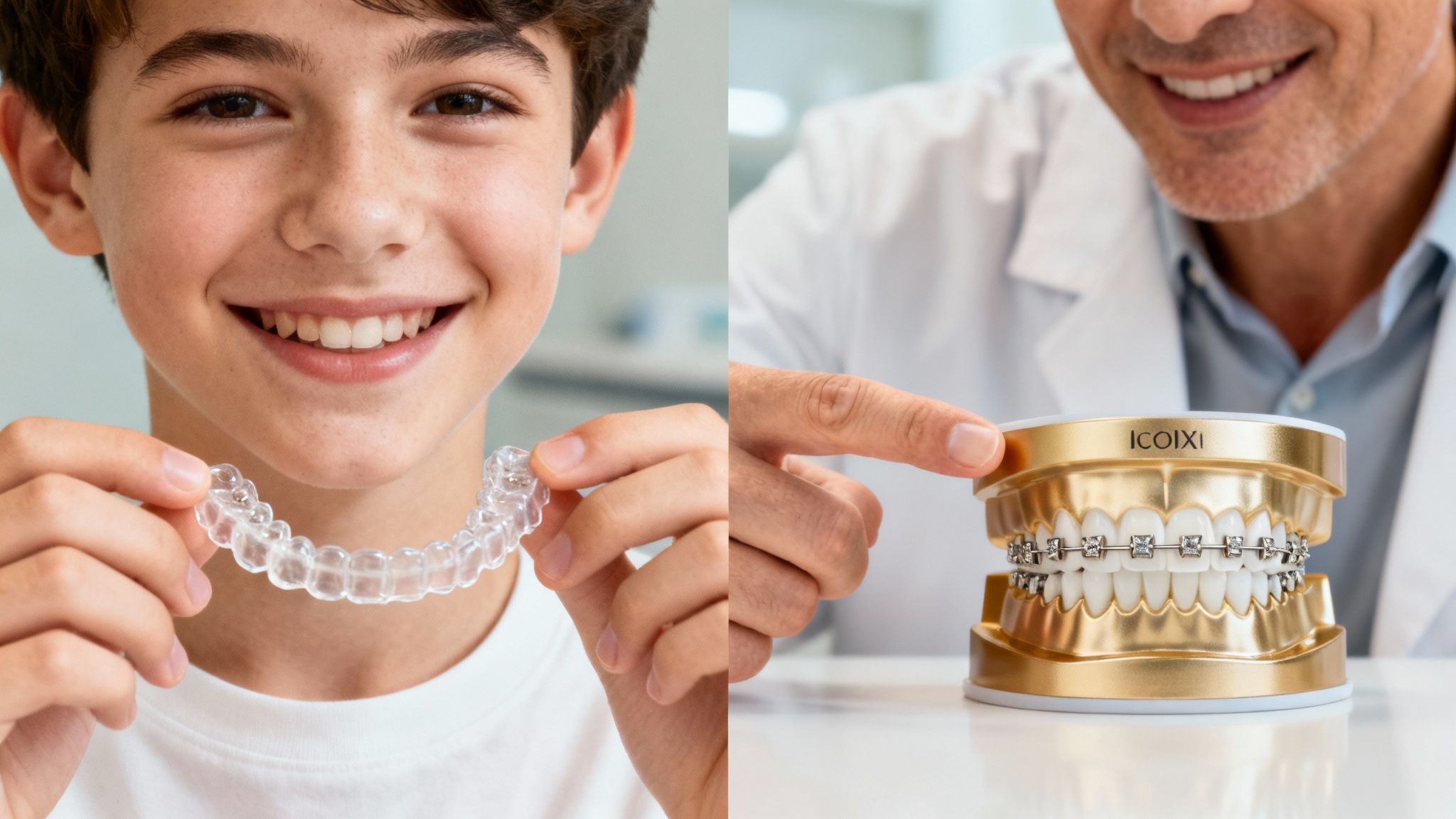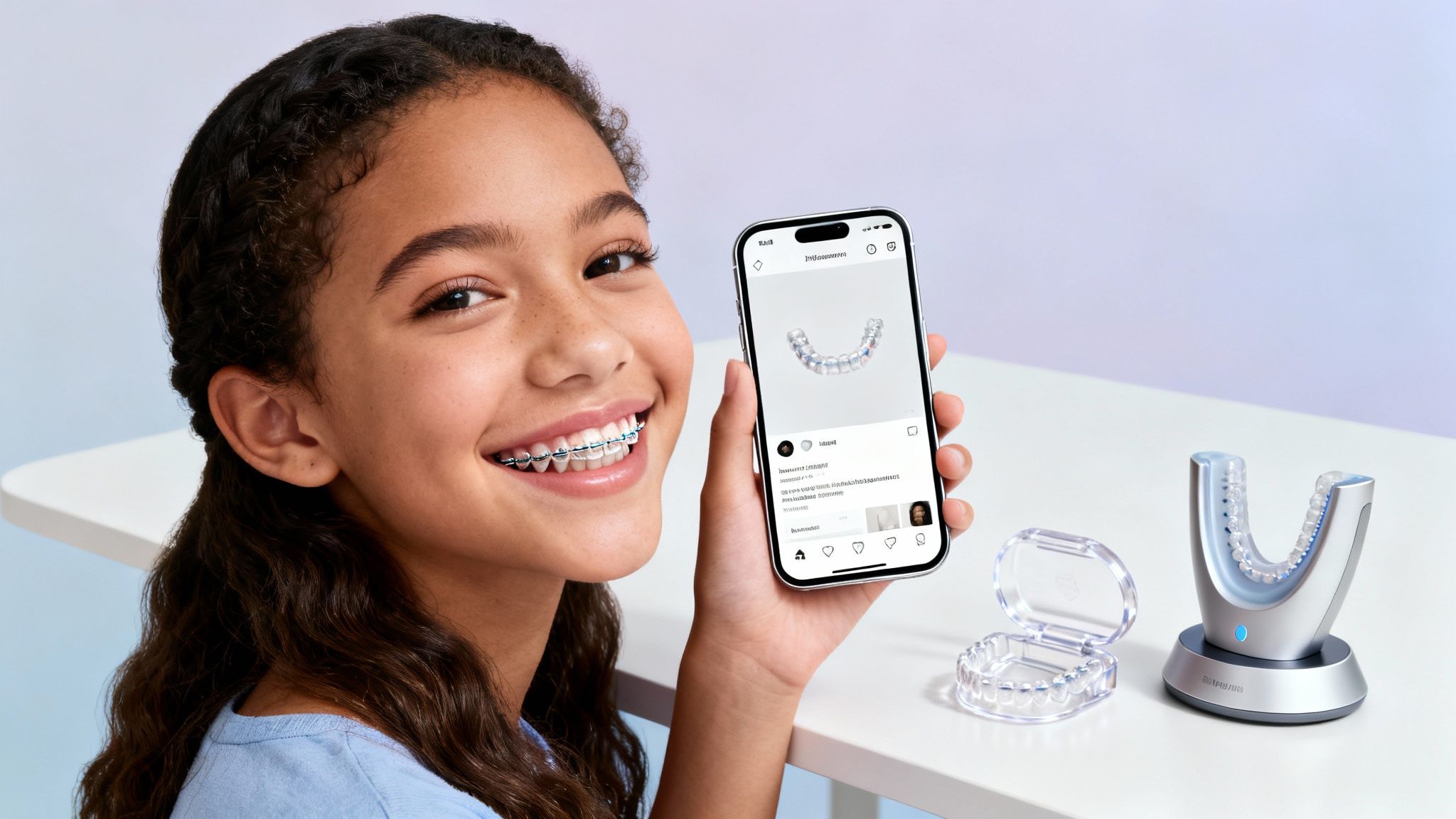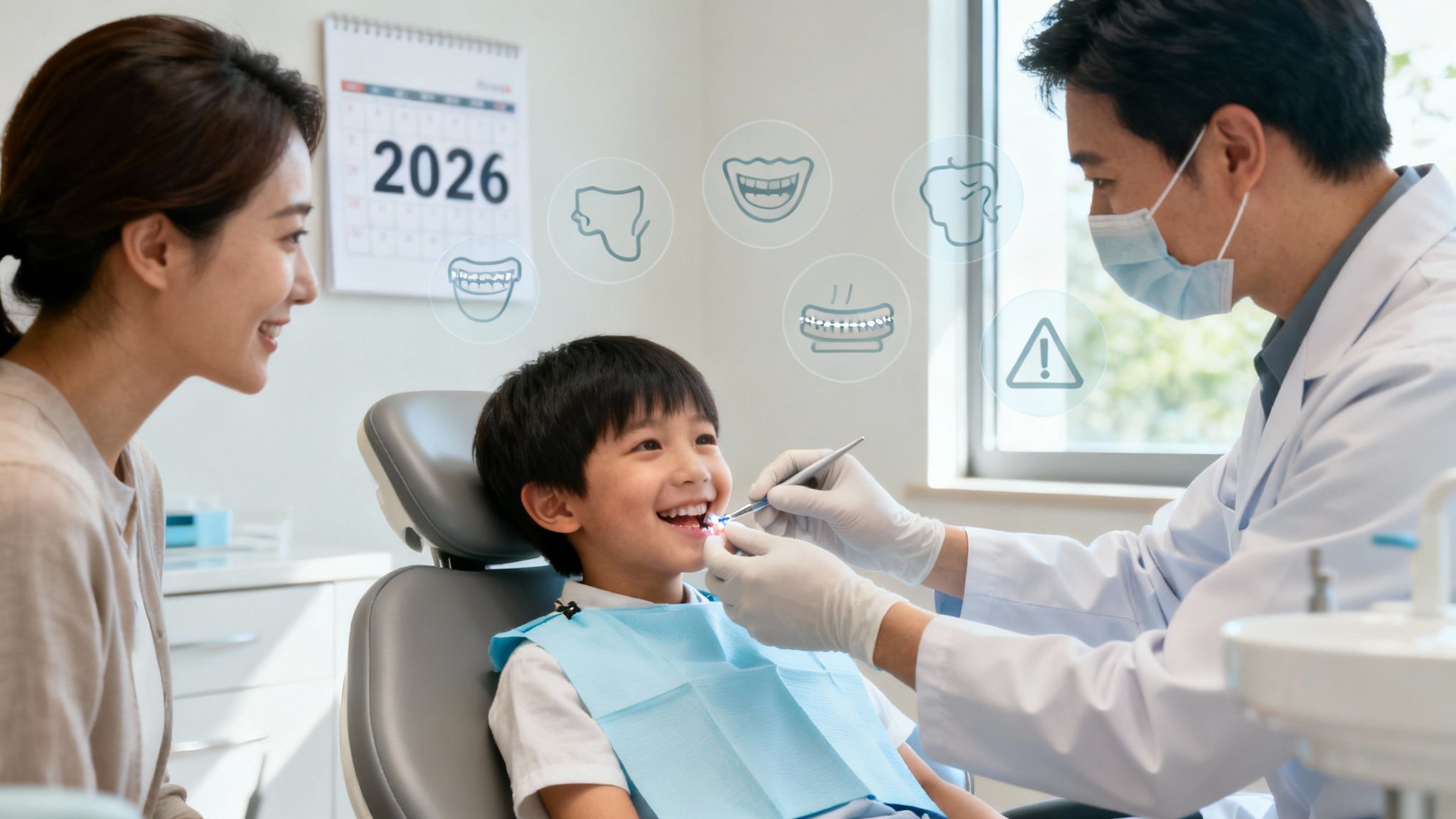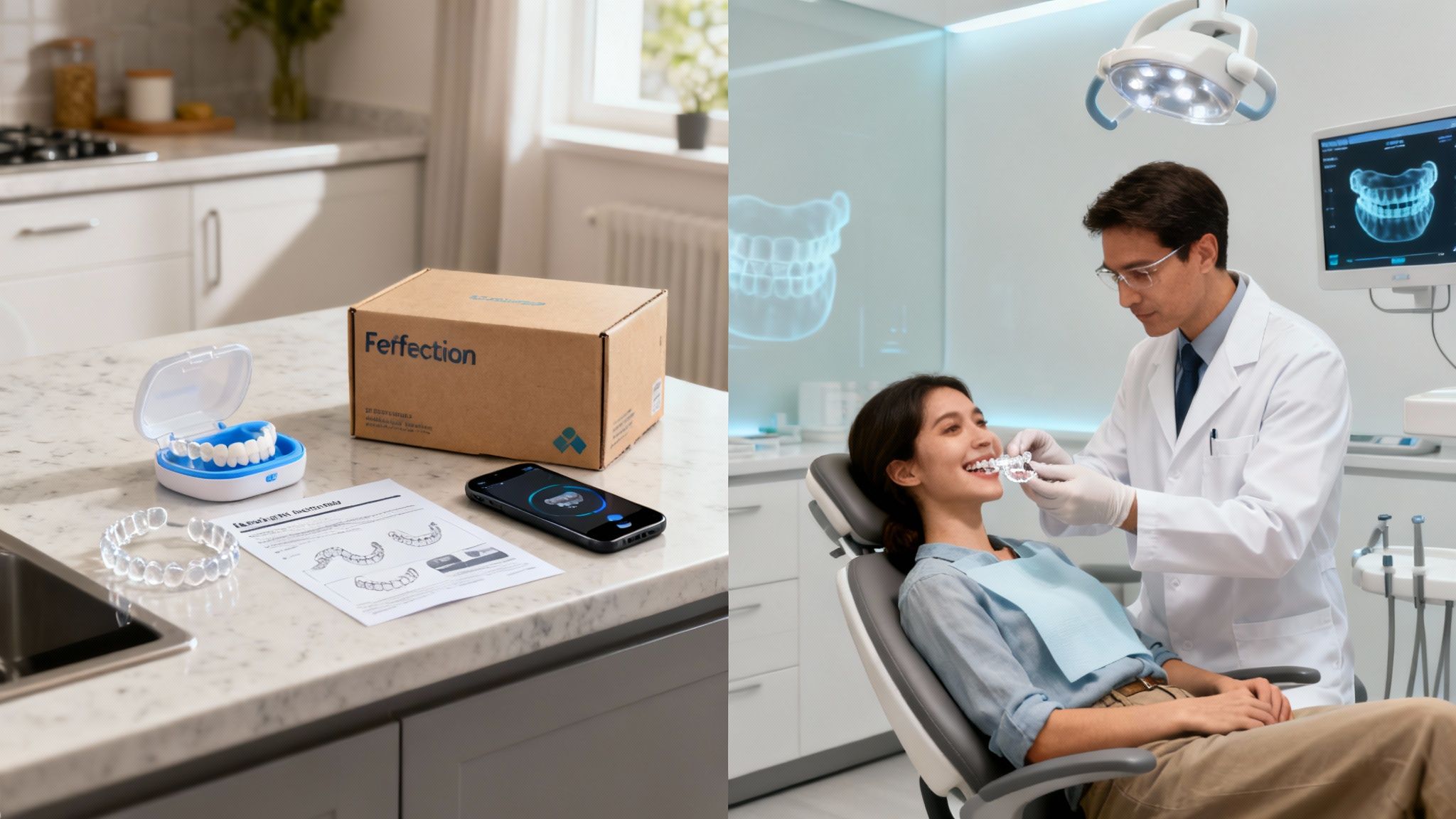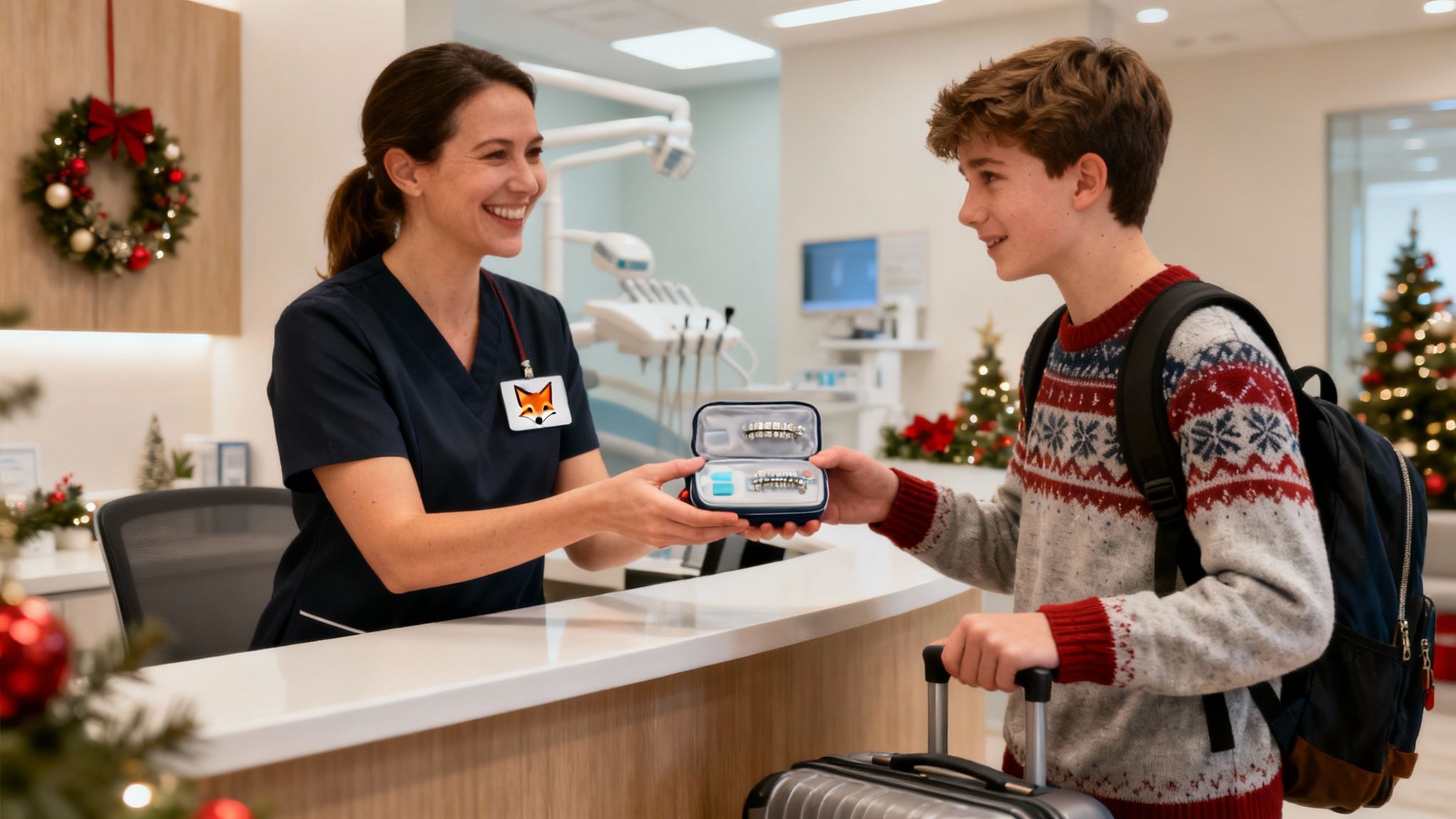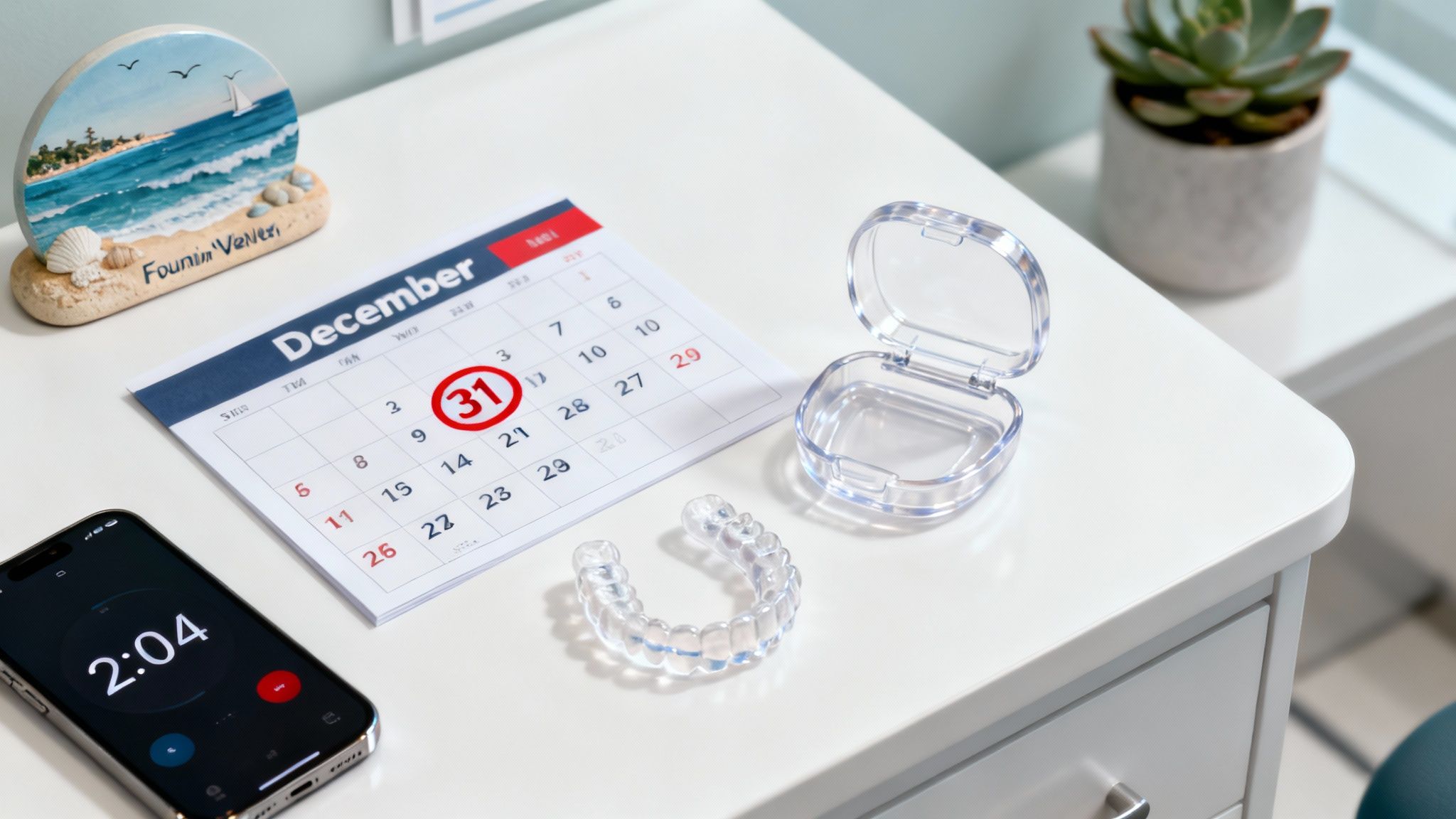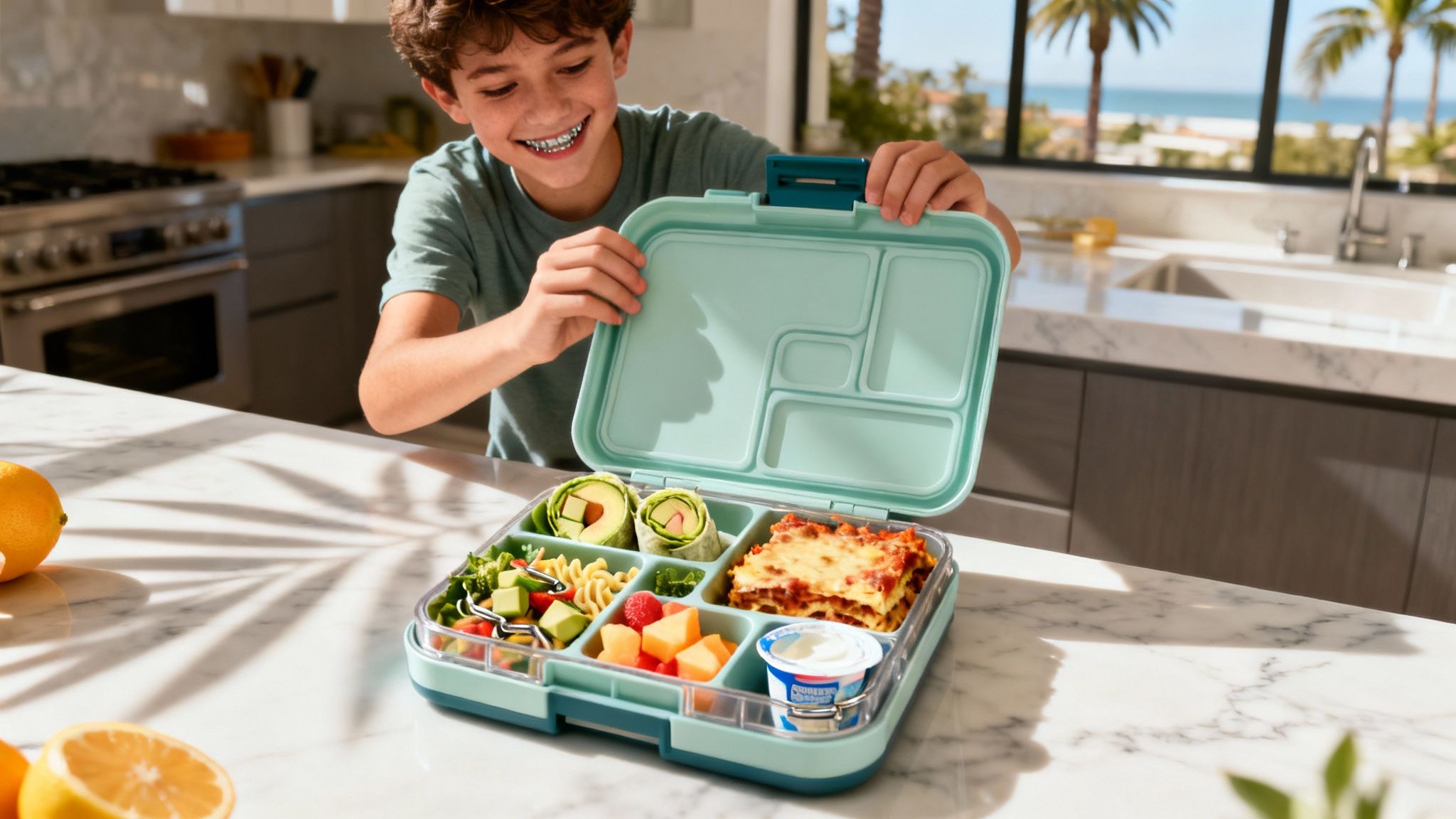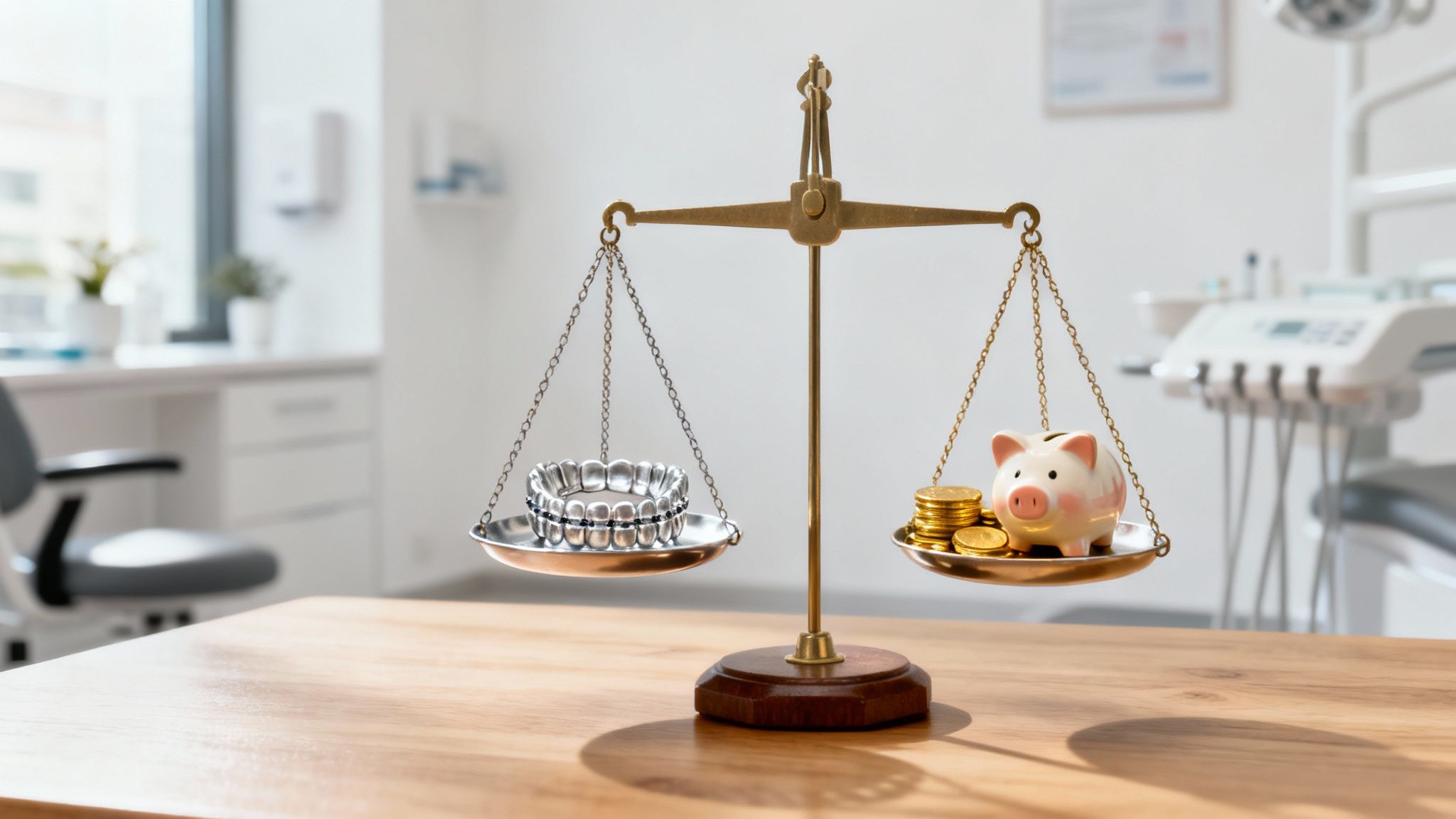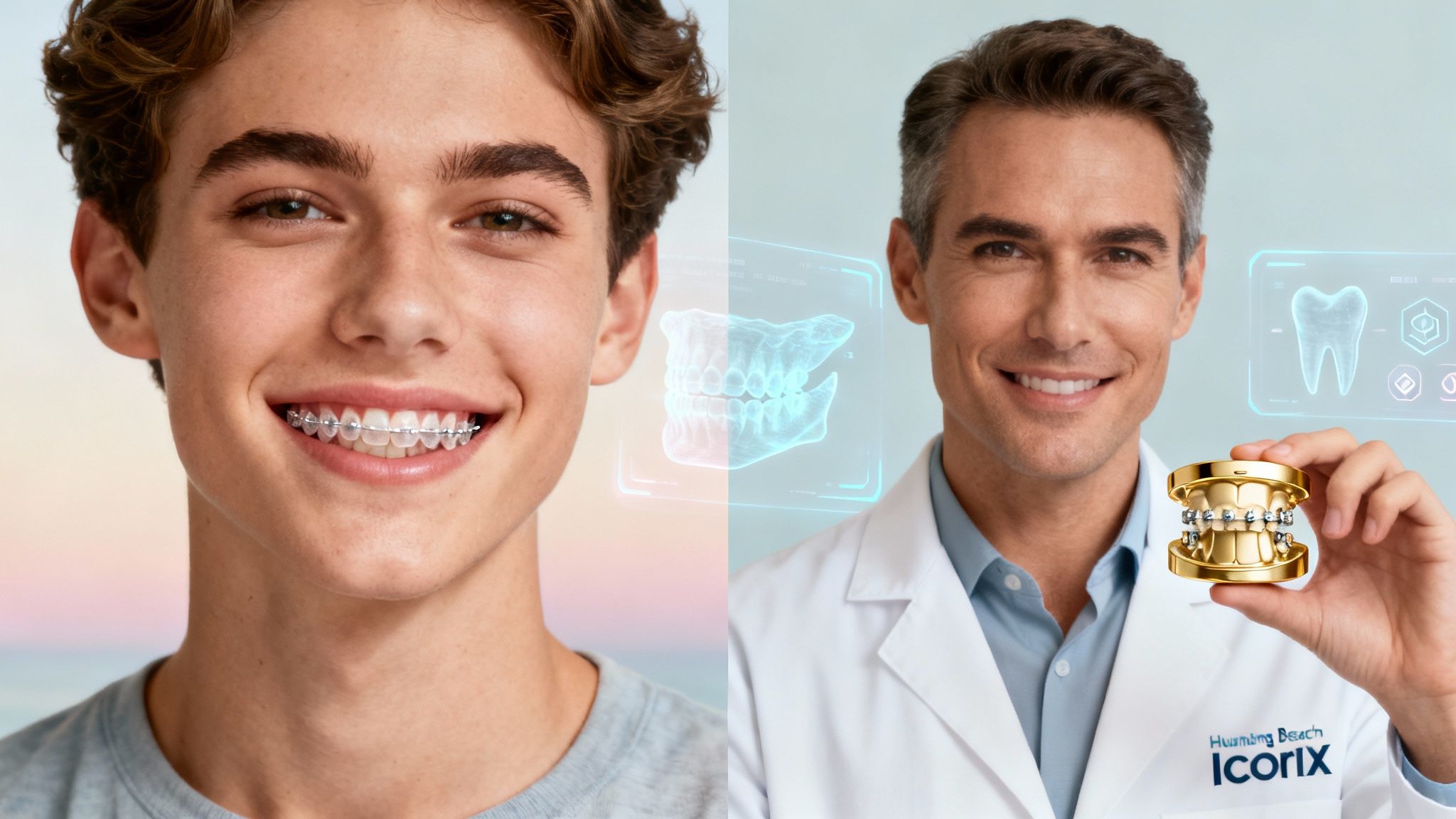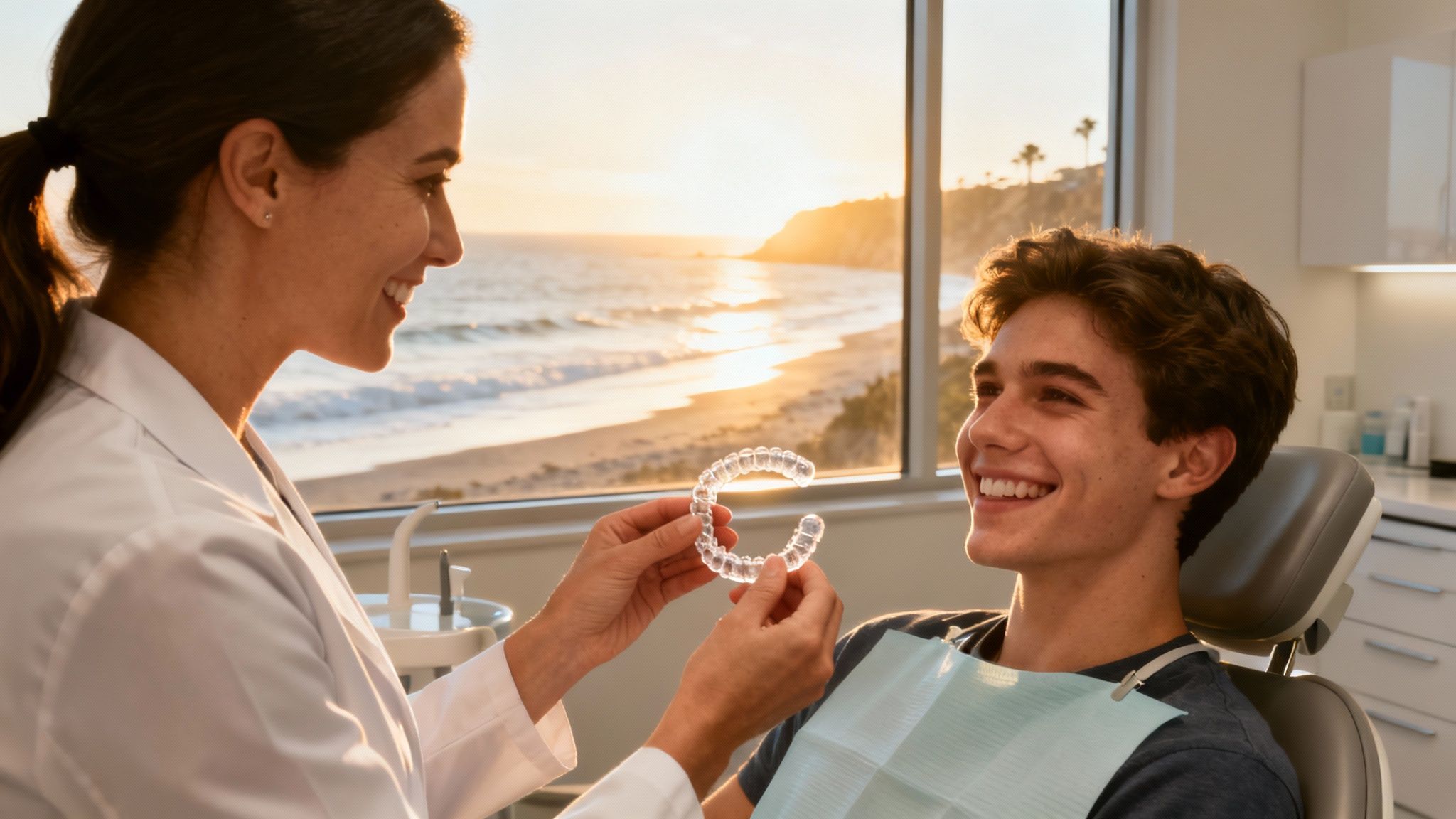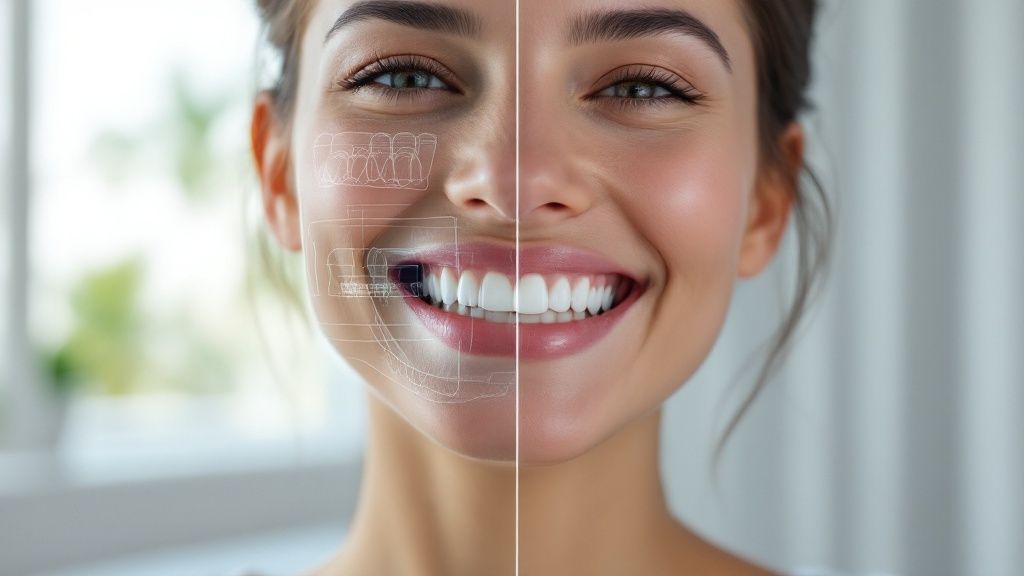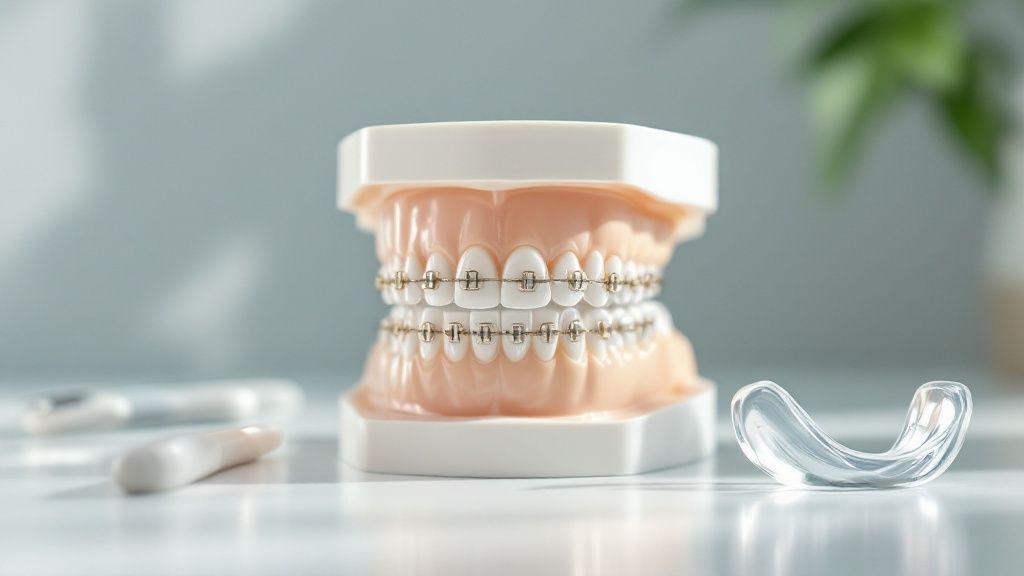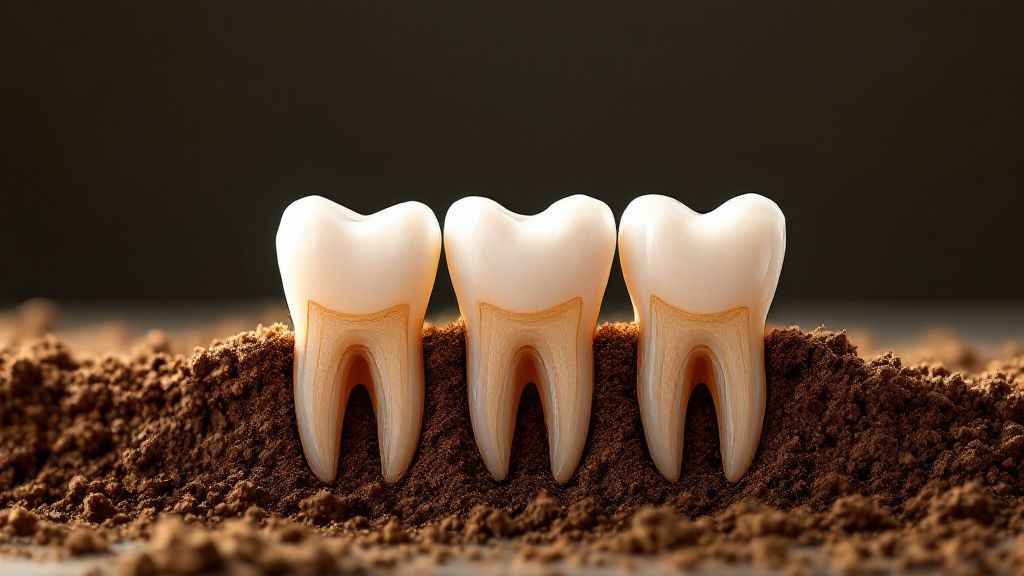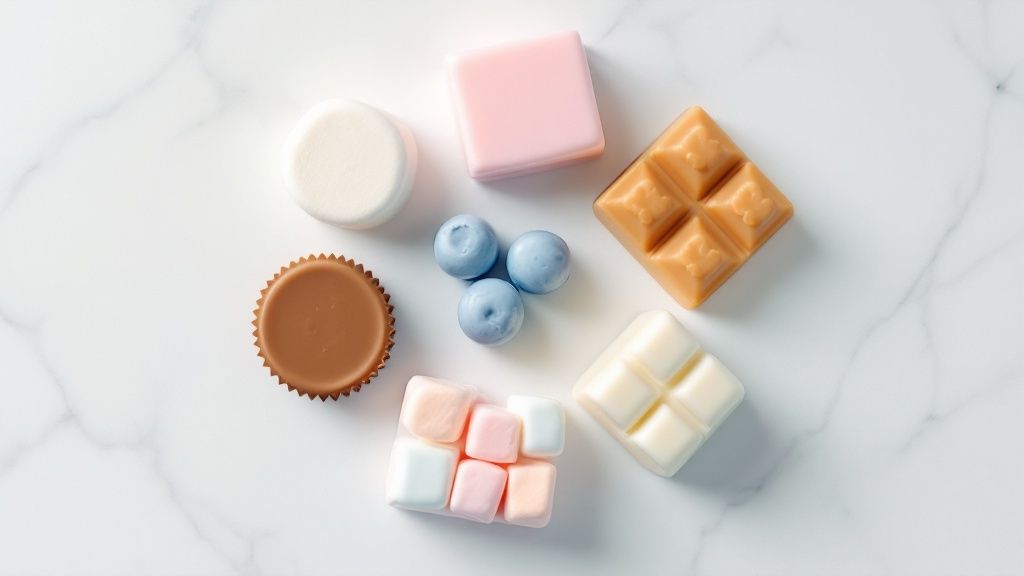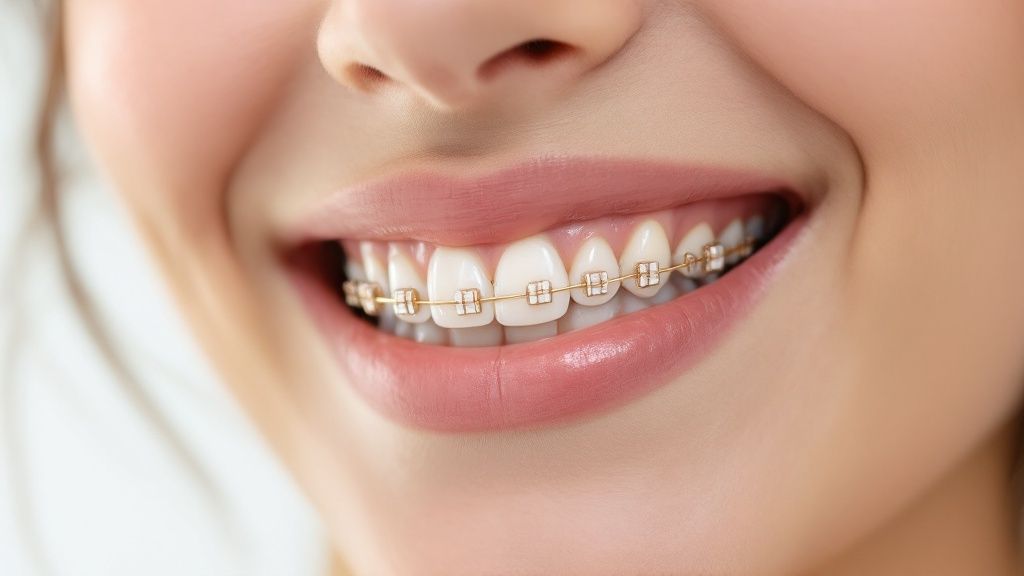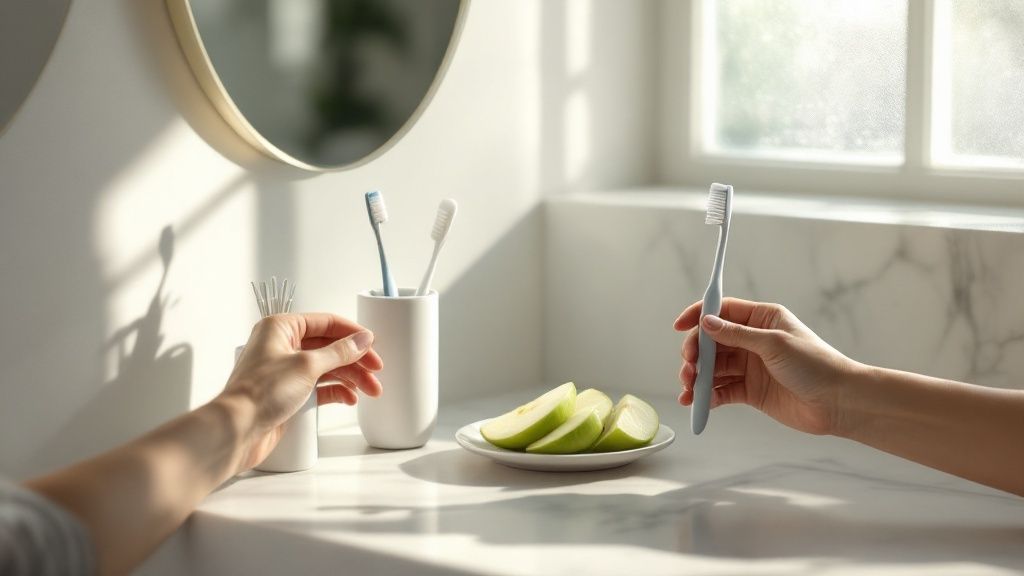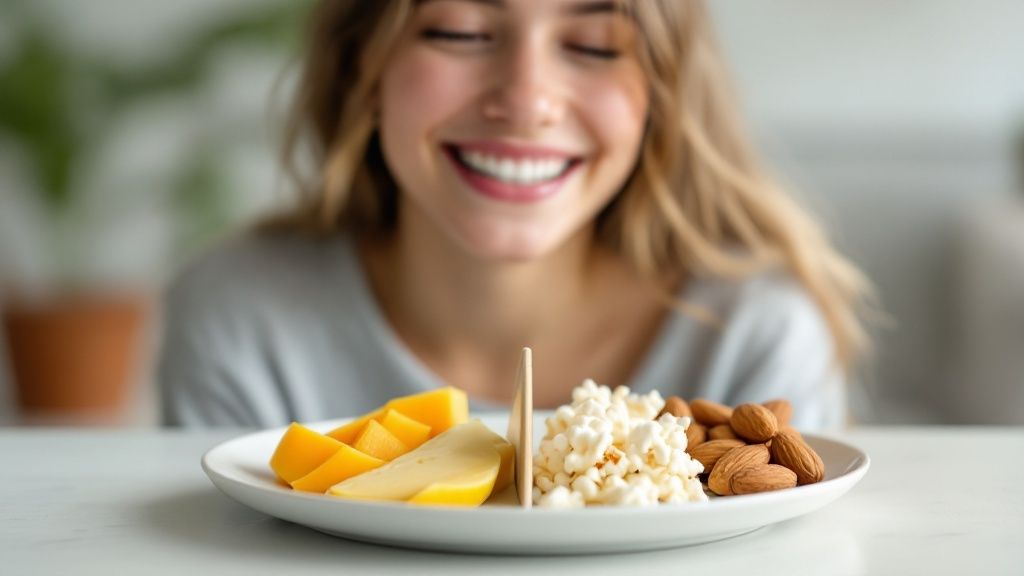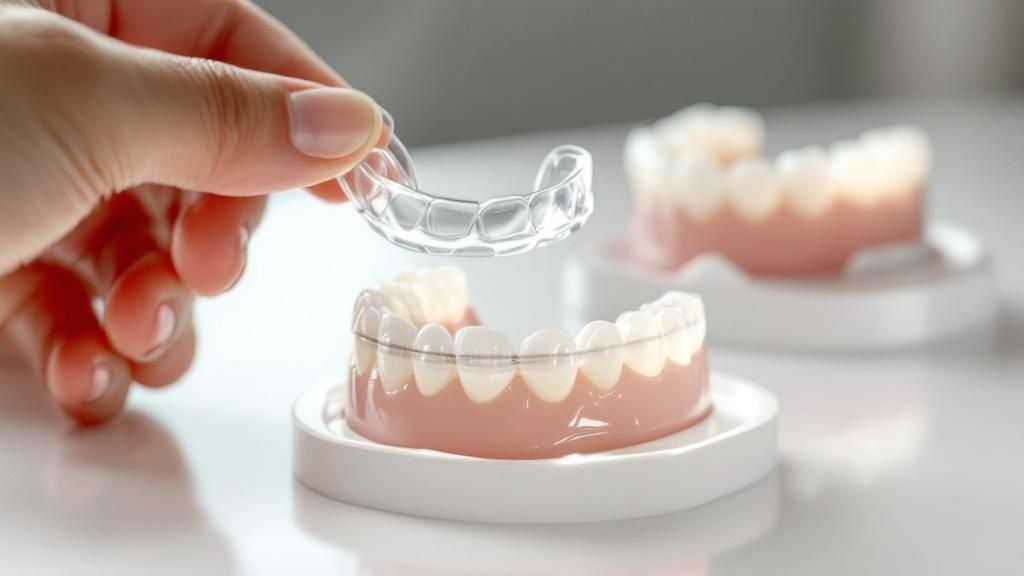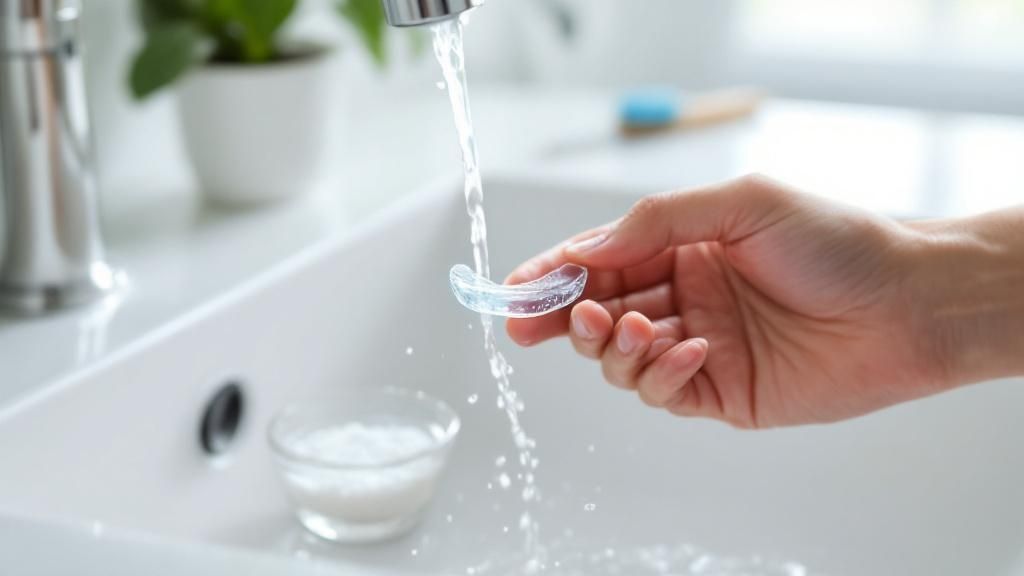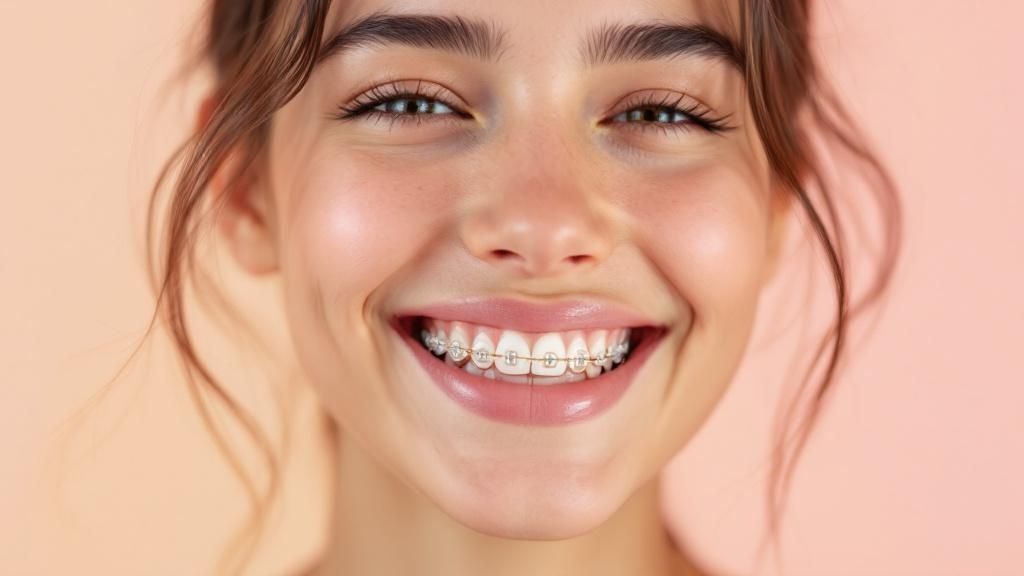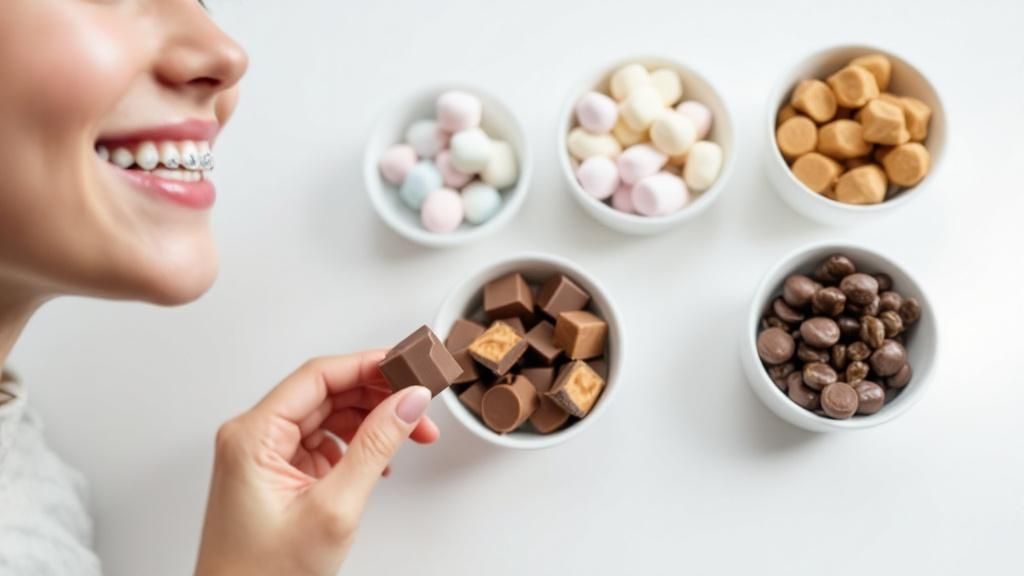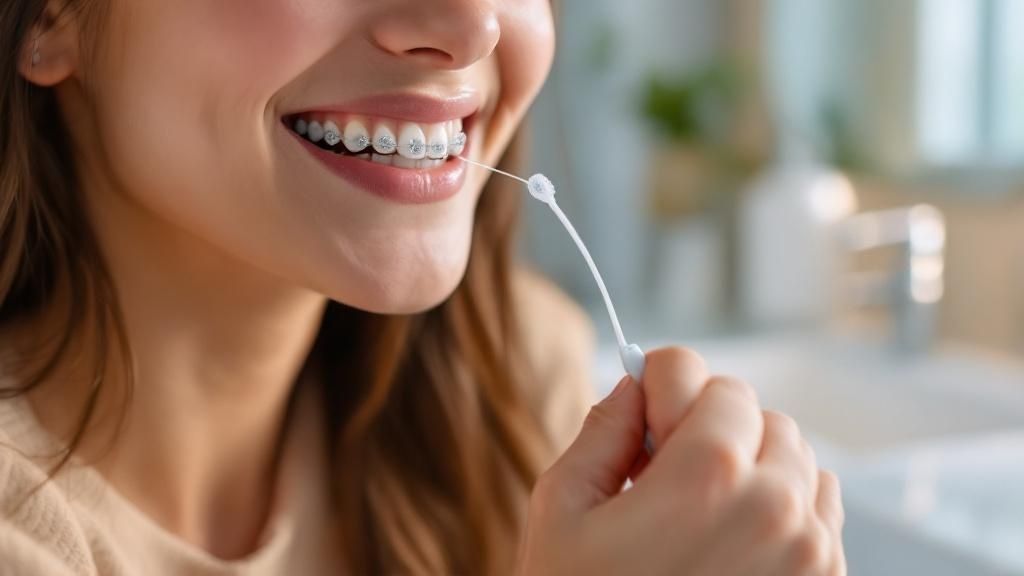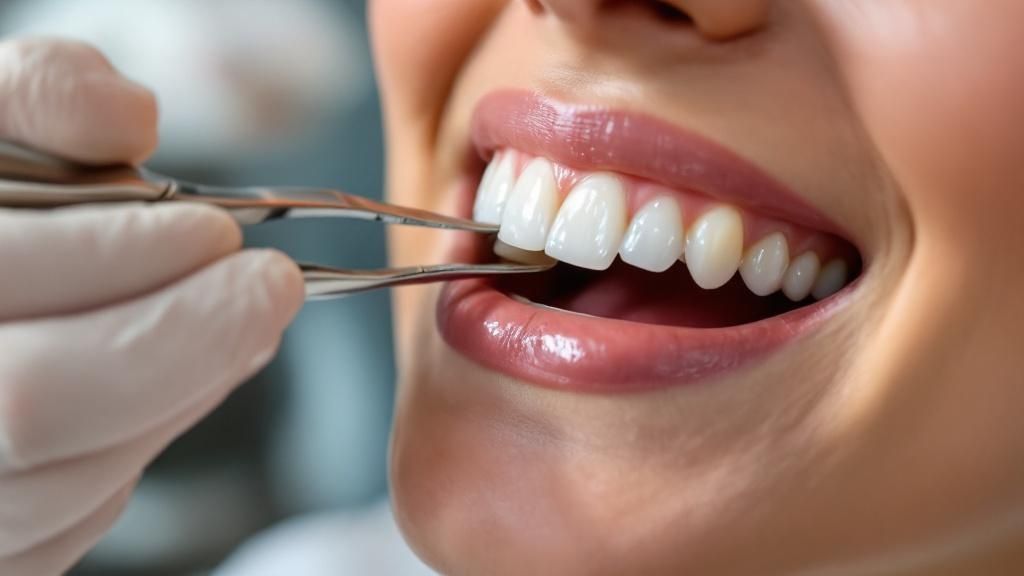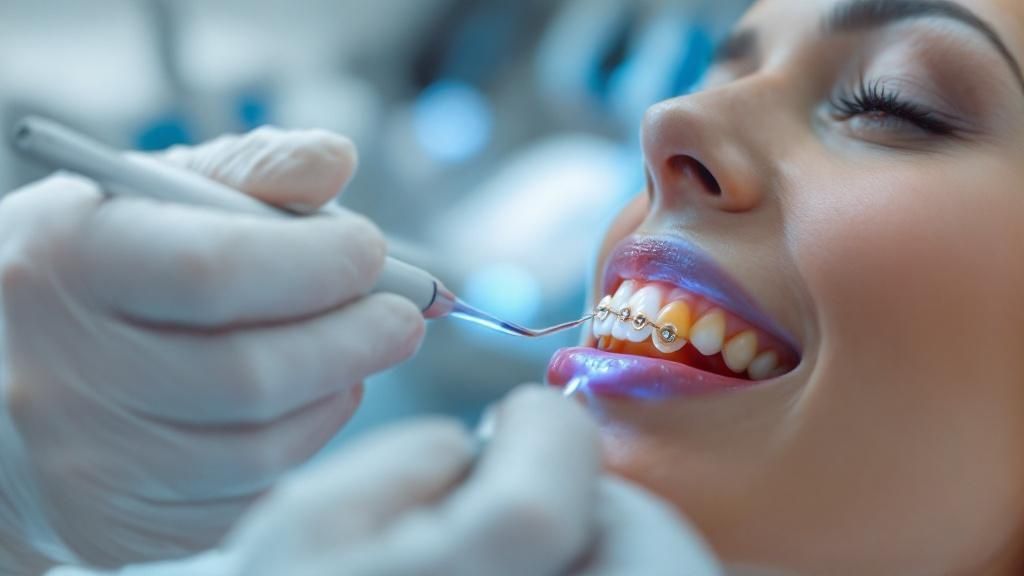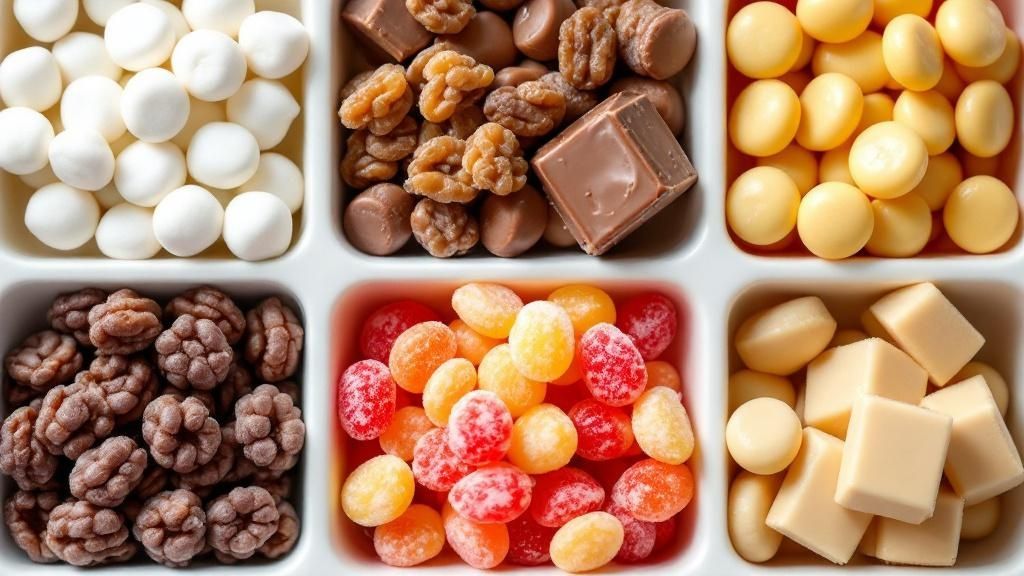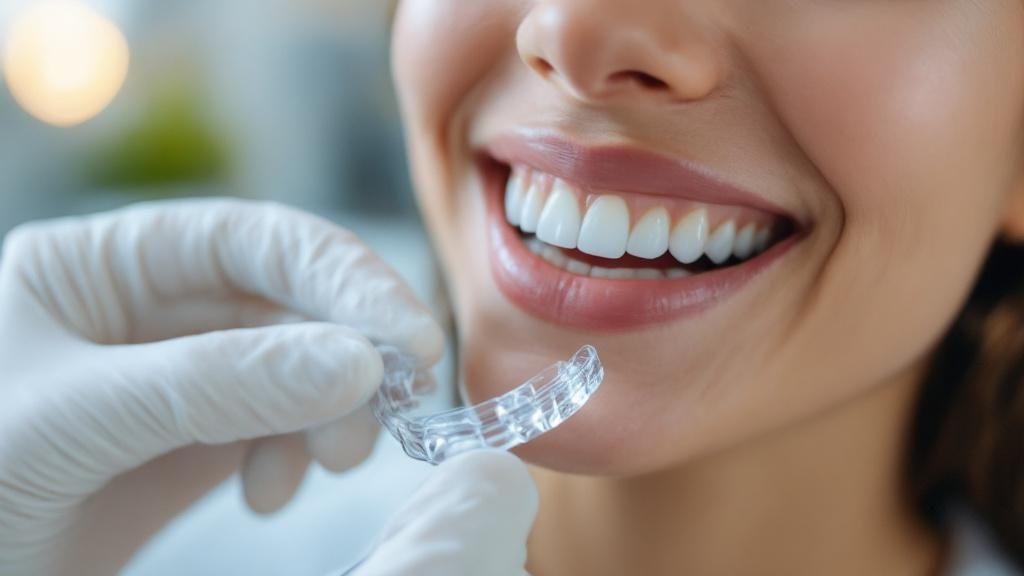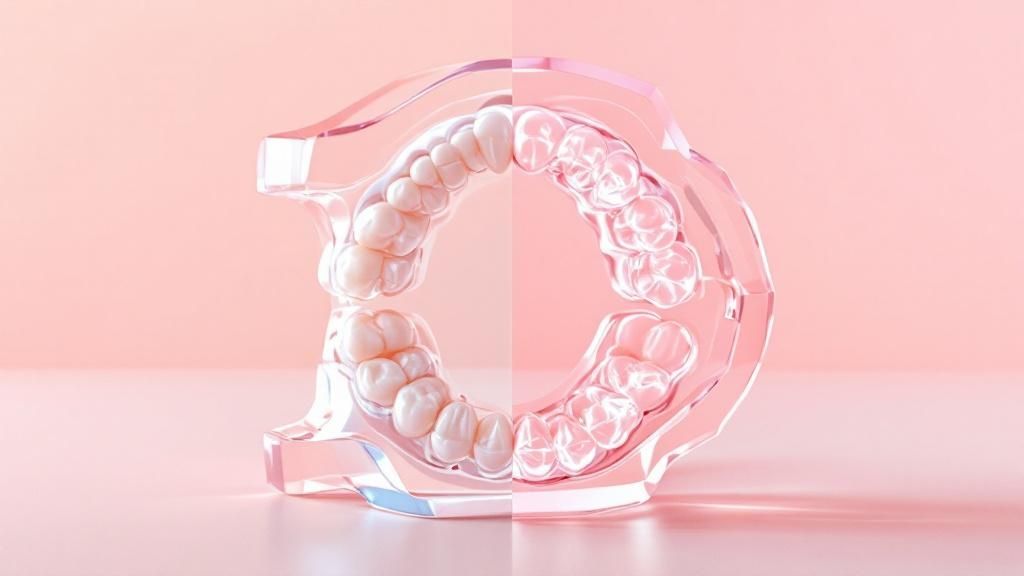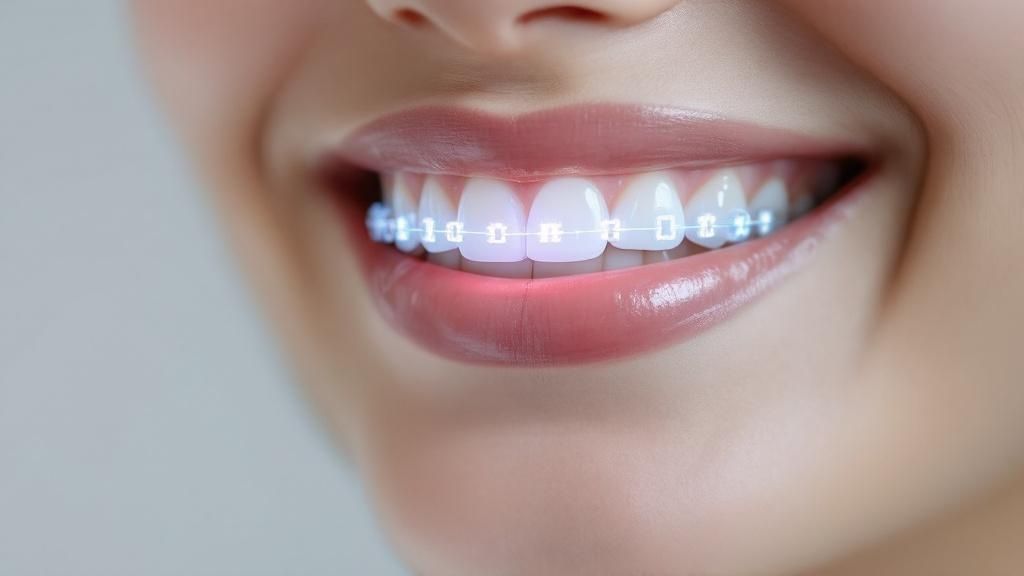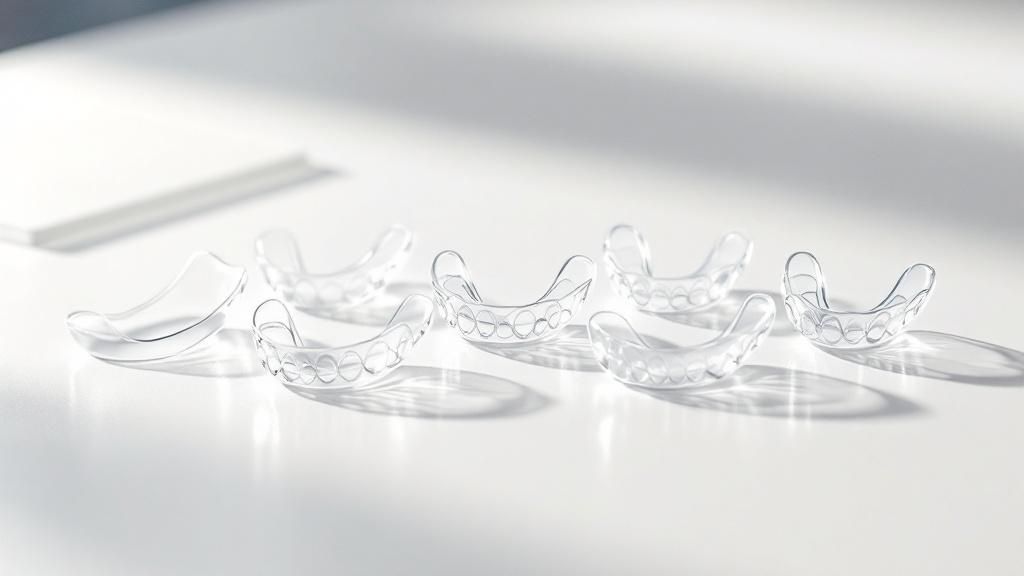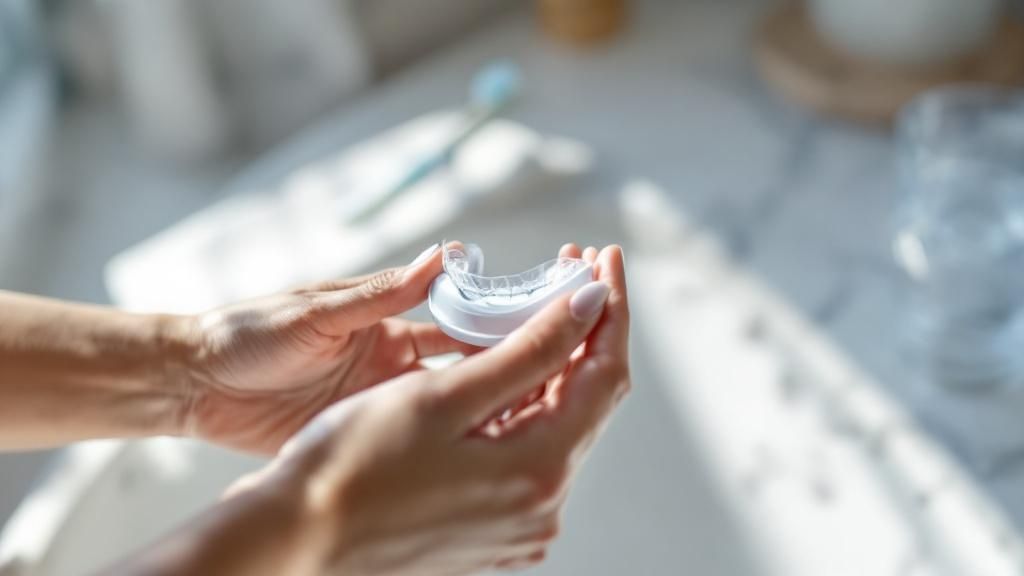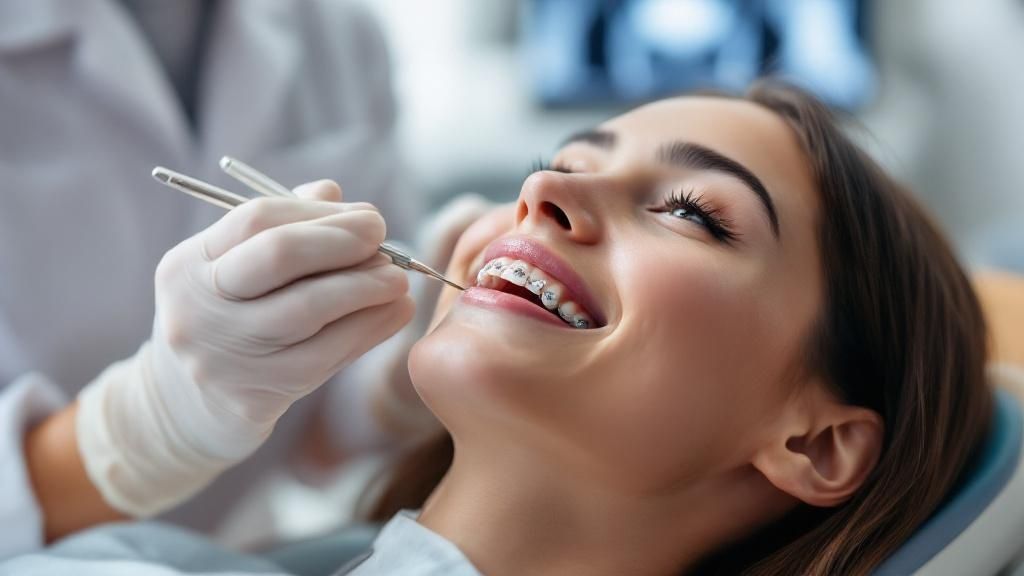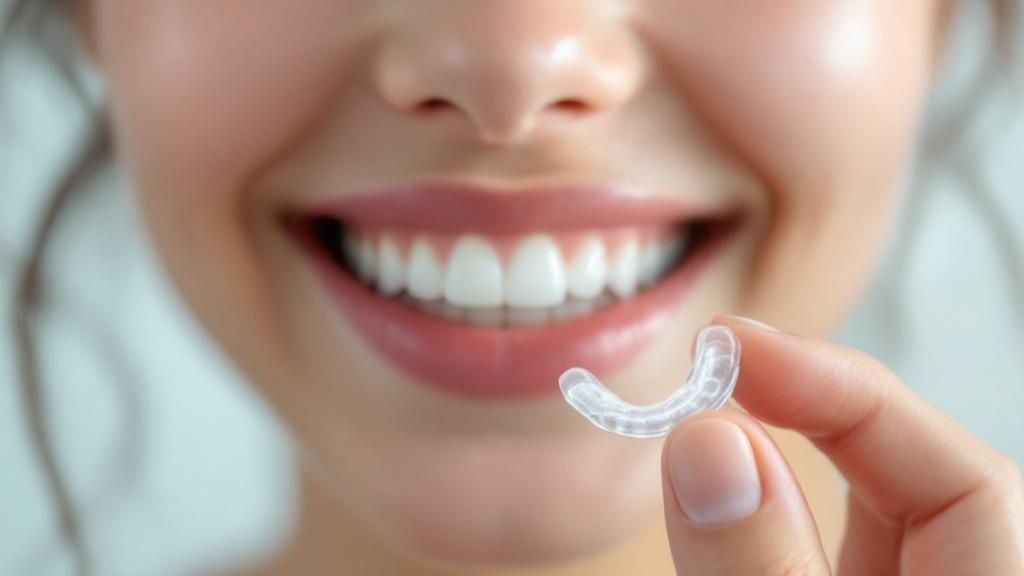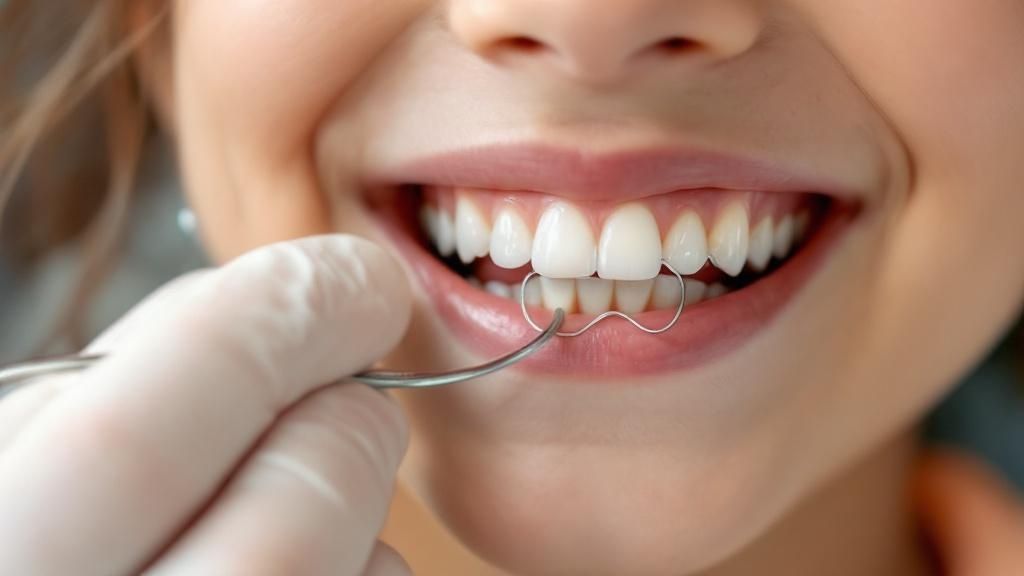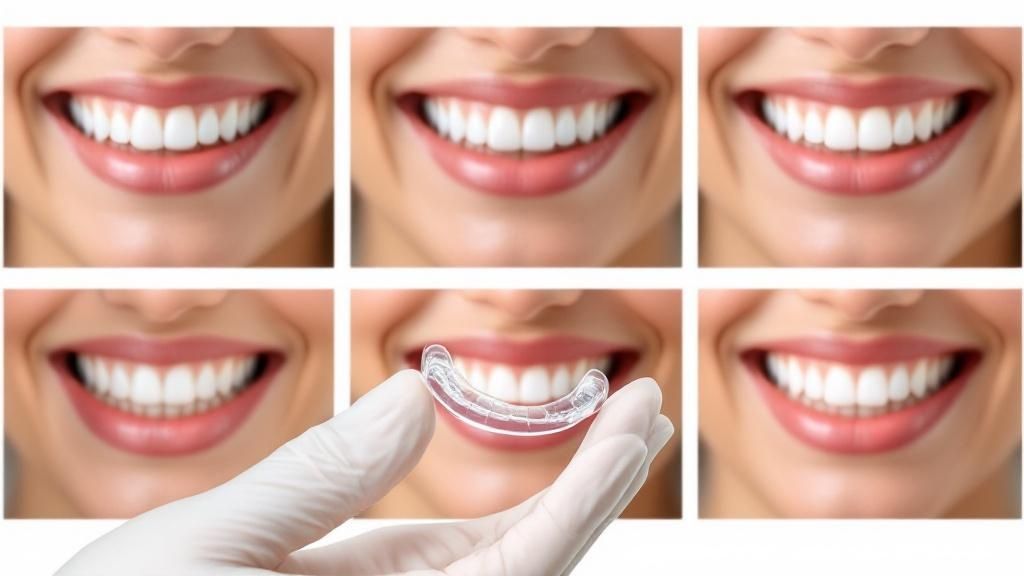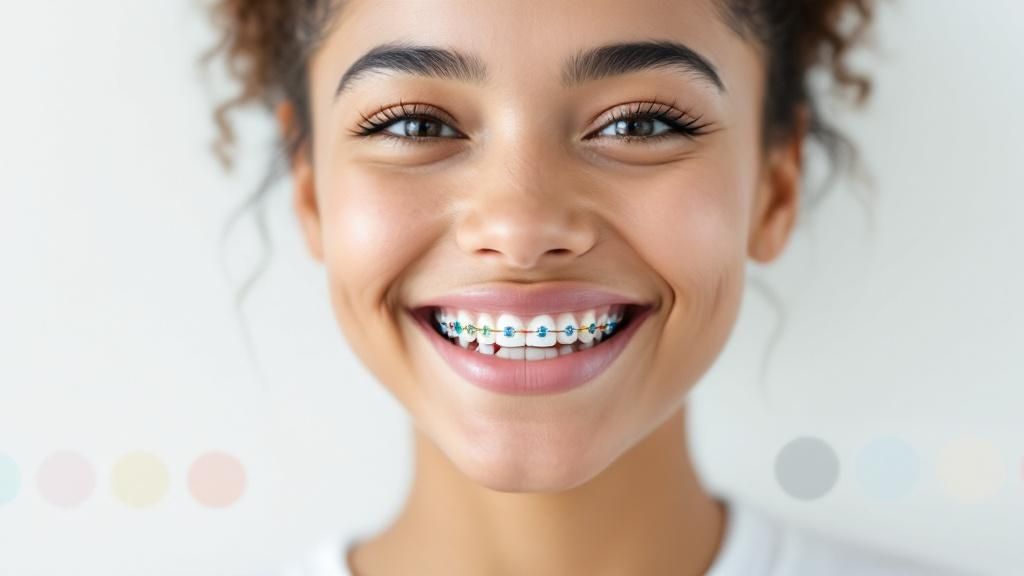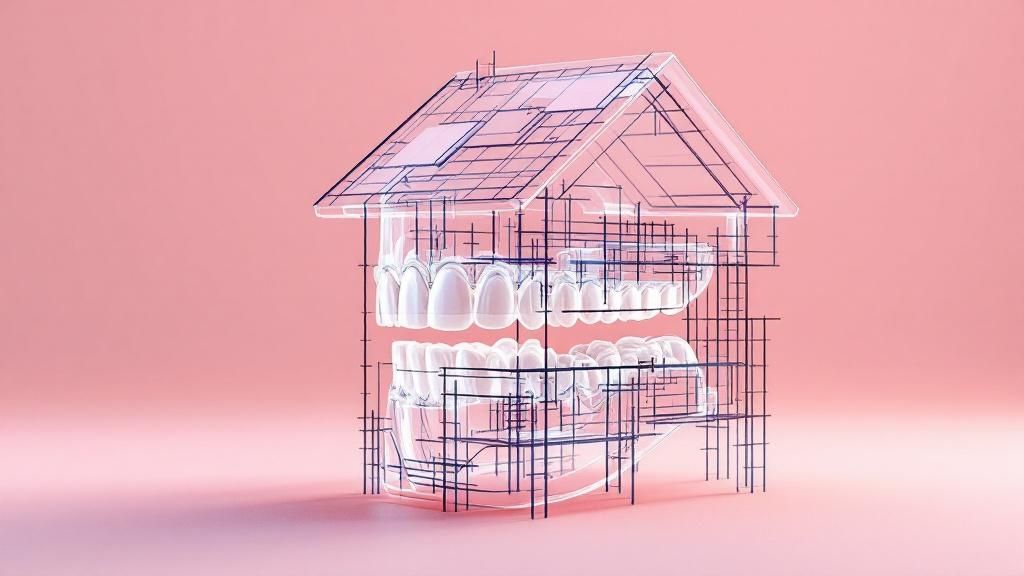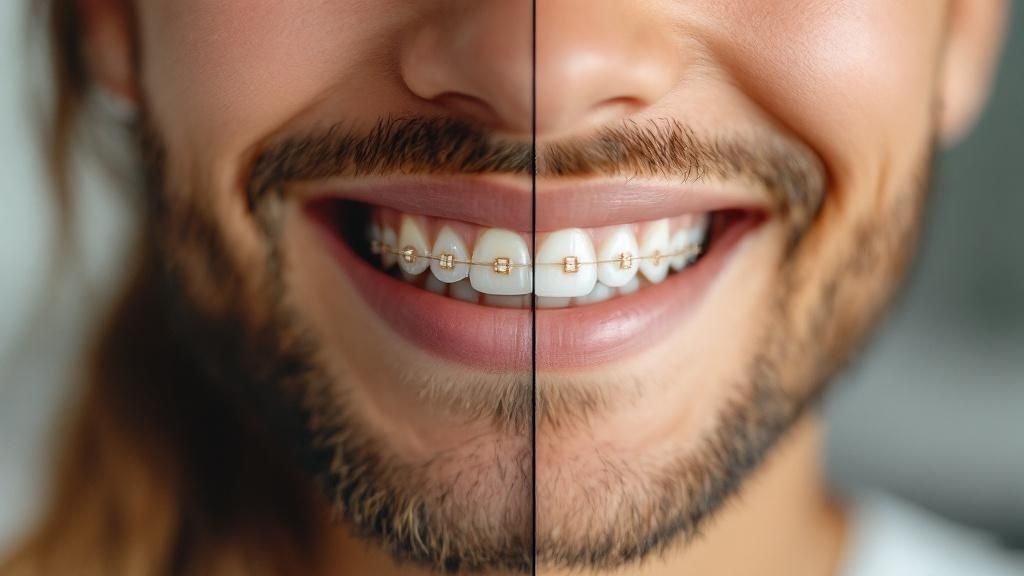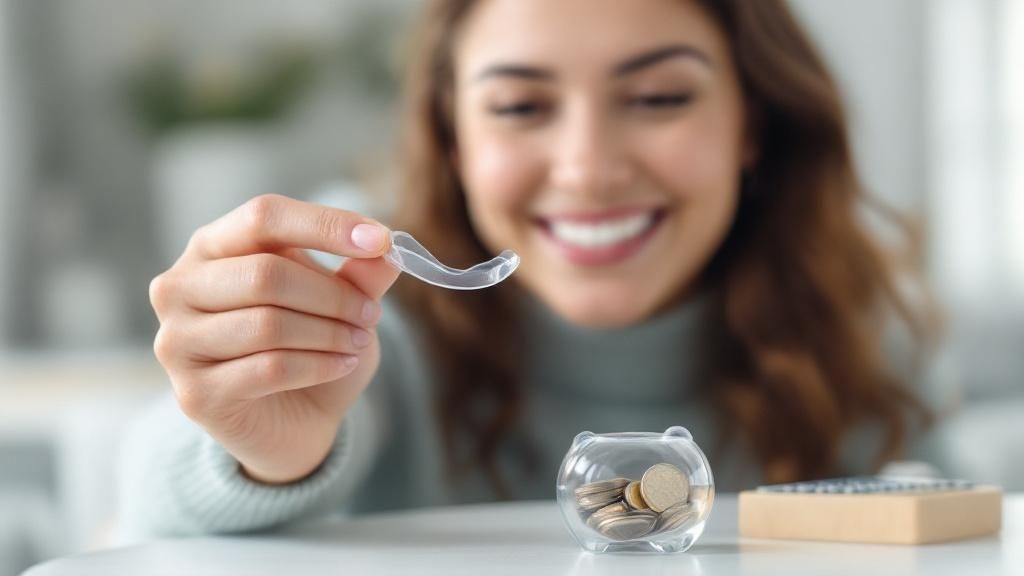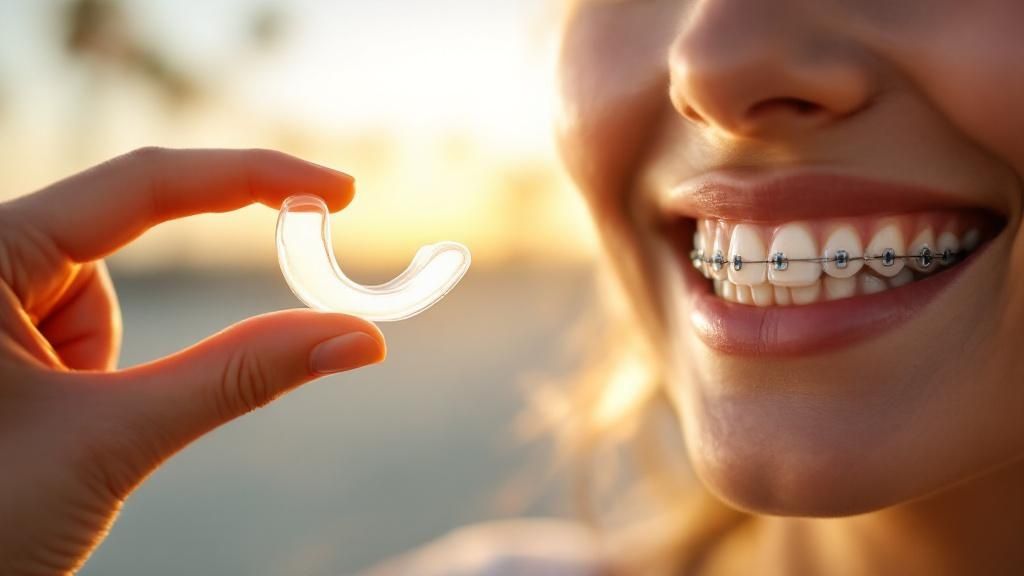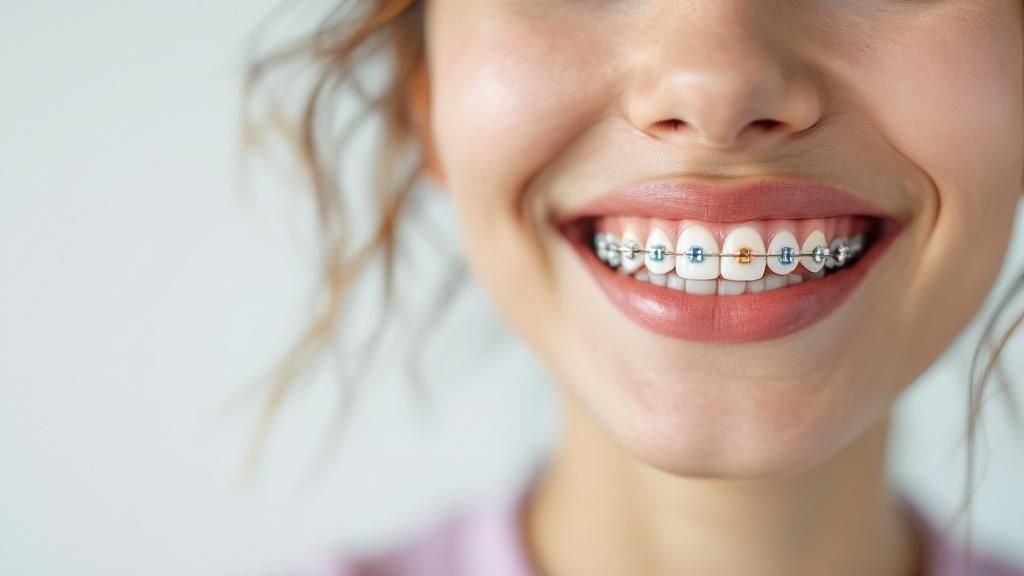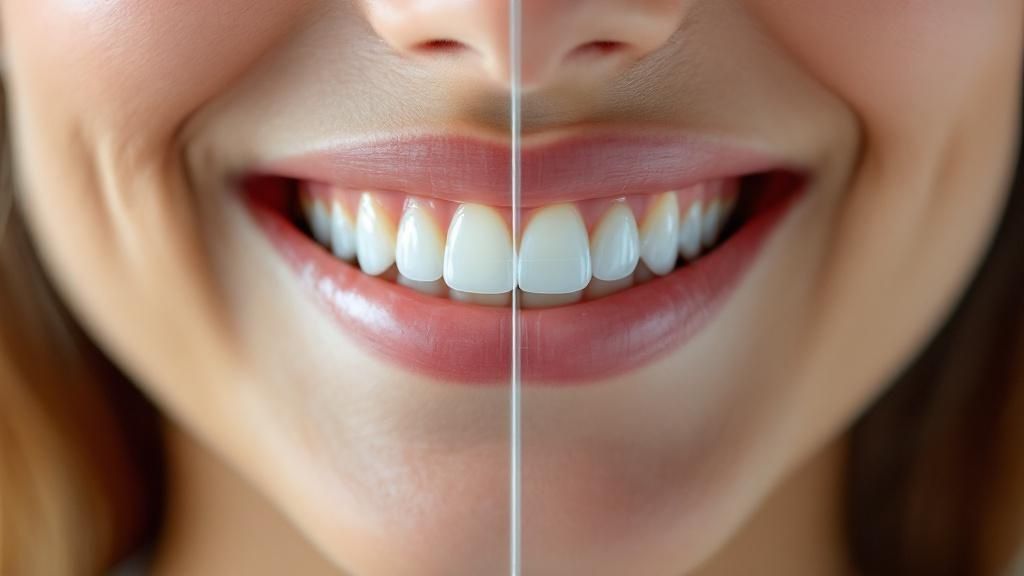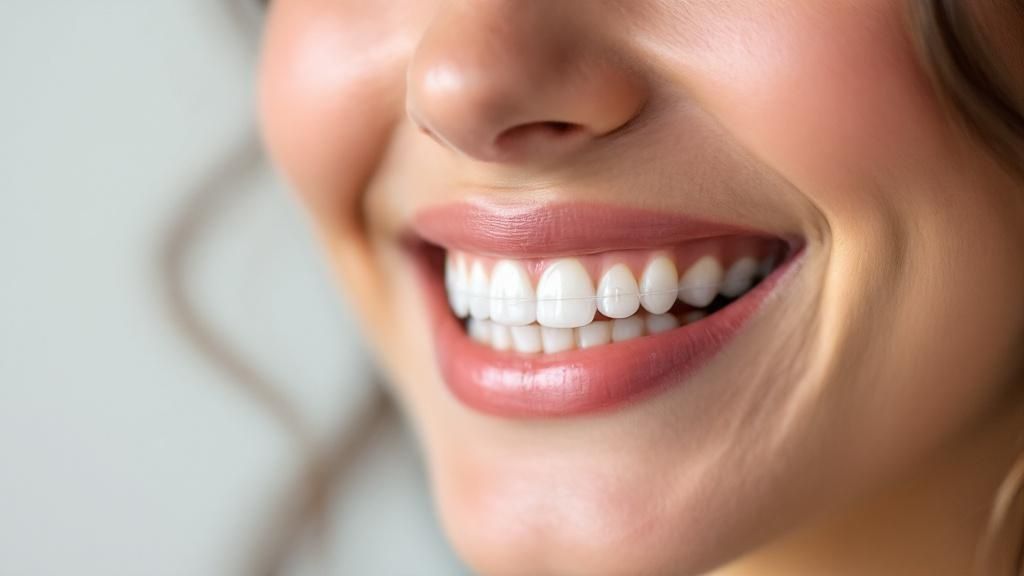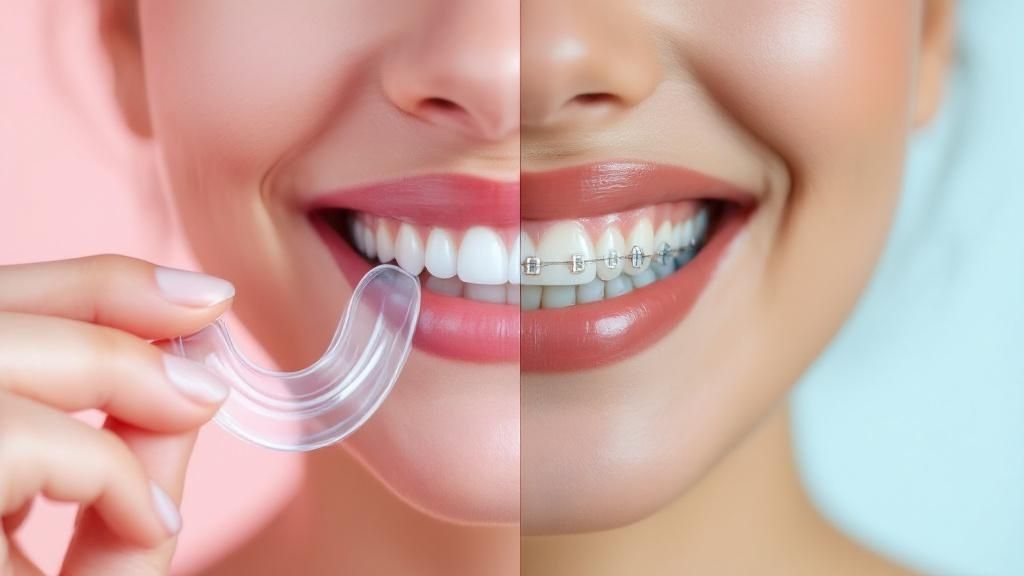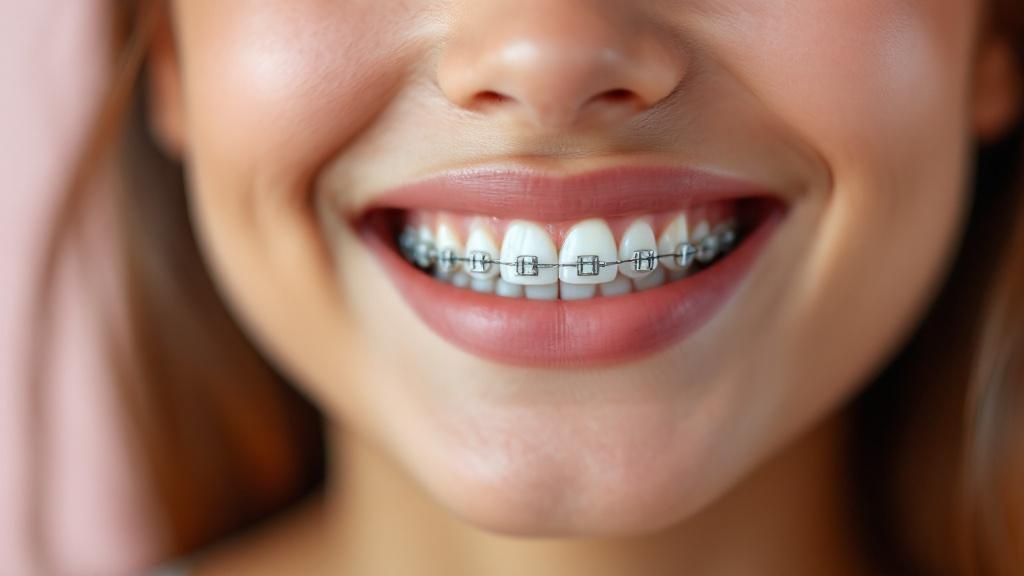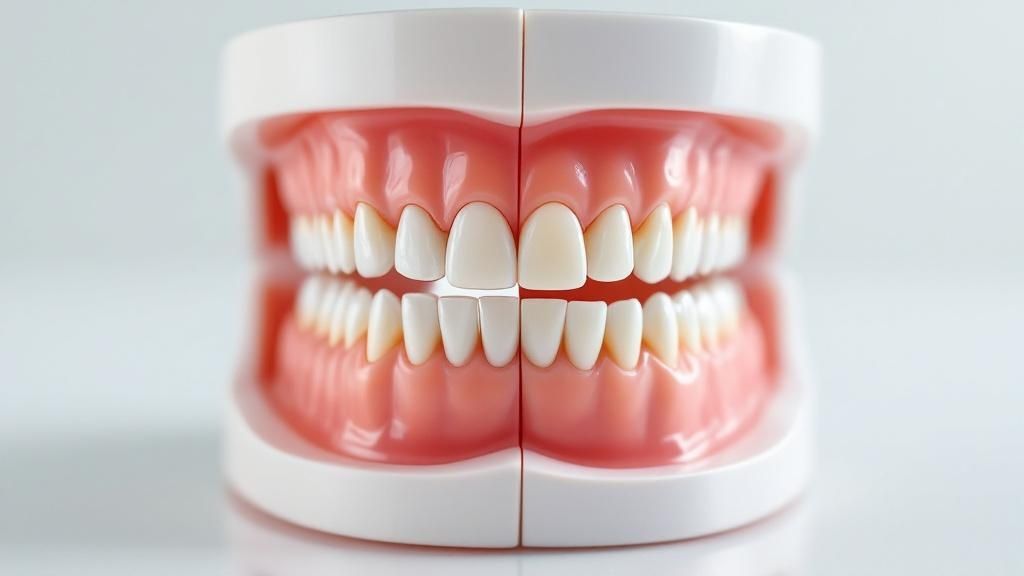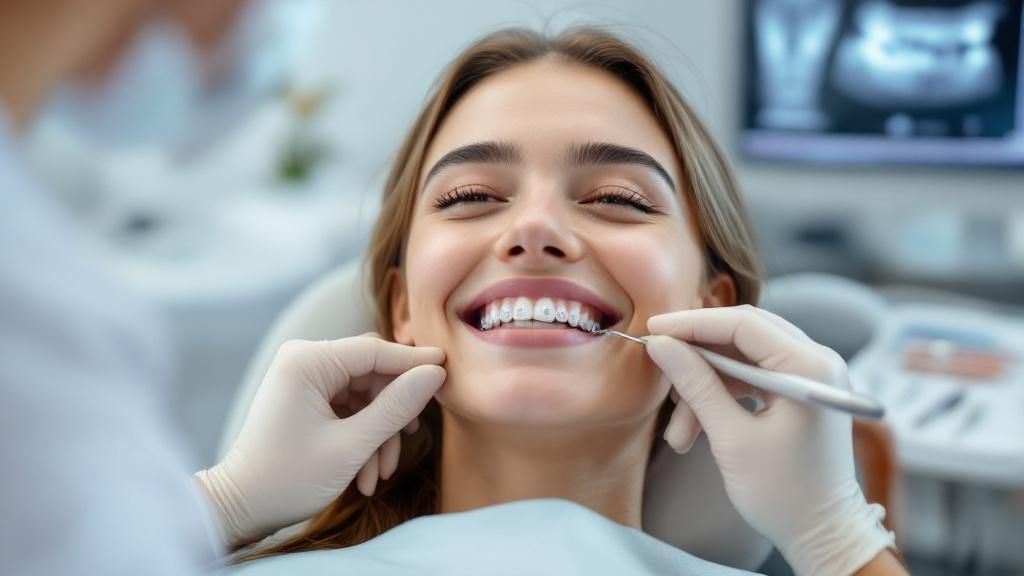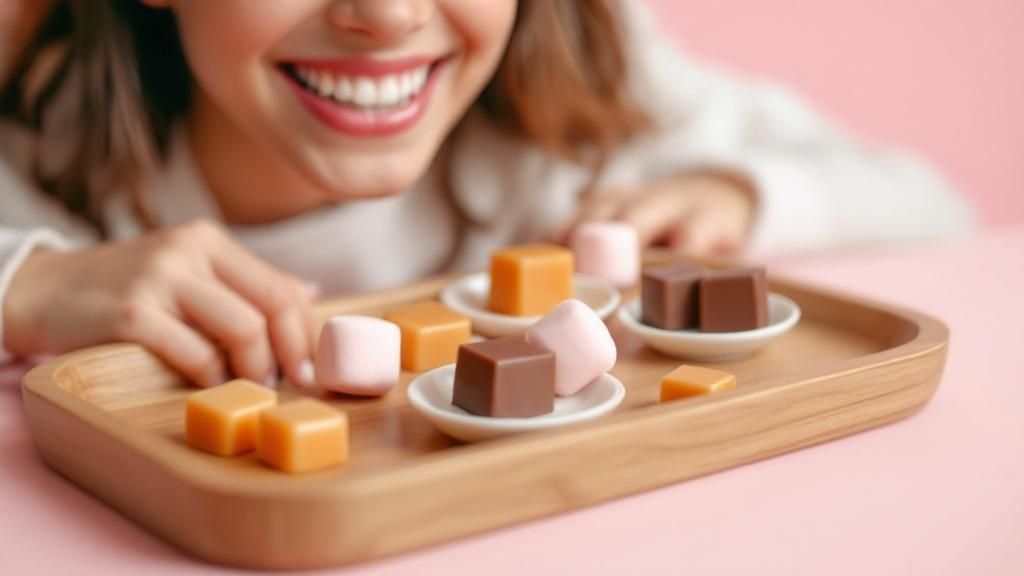
8 Best Foods to Eat with Braces: Your 2025 Guide
Navigating your new life with braces can feel like a big adjustment, especially when it comes to mealtimes. Suddenly, your favorite crunchy snacks and chewy treats are on the "do not eat" list, and you might be wondering what you can enjoy without risking a broken bracket.
For parents of kids and teens with new braces in Huntington Beach, or adults starting their own smile journey, finding satisfying and safe foods is a top priority. This guide is designed to remove the guesswork, offering a clear roadmap to meals that are not only delicious but also support your orthodontic treatment.
We will explore a variety of the best foods to eat with braces, from soft fruits and cooked vegetables to satisfying proteins and even some braces-friendly desserts. To further support your journey, exploring delicious no-sugar diet recipes can provide excellent meal ideas that are kind to your braces. Let's dive into the options that will keep you well-fed and smiling from your first day in braces to your last.
1. Soft Fruits
When you first get your braces or after an adjustment, your teeth and gums can feel tender. Soft fruits are one of the best foods to eat with braces because they are naturally gentle and packed with essential vitamins.
Their tender texture requires minimal chewing, reducing pressure on sensitive teeth and protecting your orthodontic brackets and wires from damage.

Why Soft Fruits are a Top Choice
Choosing the right fruits helps ensure you get necessary nutrients without risking your orthodontic investment. For example, bananas are rich in potassium and Vitamin B6, making them a perfect, soft, grab-and-go snack.
Berries like blueberries and raspberries, loaded with antioxidants, can be easily added to yogurt or oatmeal for a braces-friendly breakfast. Understanding how different foods impact your orthodontic timeline is important; learn more about how long braces take and how your diet can play a role at Magic Fox Orthodontics.
Tips for Safe and Enjoyable Consumption
To make fruit even easier on your braces, follow these simple preparation tips:
- Cut into Bite-Sized Pieces: Always cut larger fruits like melons or peeled peaches into small, manageable cubes. This eliminates the need to bite directly into the fruit, which can dislodge a bracket.
- Choose Seedless Varieties: Opt for seedless grapes or watermelon. Small, hard seeds can easily get lodged in your hardware, making cleaning difficult.
- Blend into Smoothies: For ultimate comfort, blend your favorite soft fruits into a delicious and nutritious smoothie. This is an excellent way to get your daily fruit intake without any chewing at all.
- Rinse After Eating: Fruits contain natural sugars. Be sure to rinse your mouth with water after snacking to help wash away sugar and acid.
2. Cooked Vegetables
Getting the right nutrients is vital for healthy teeth, but raw, crunchy vegetables can pose a risk to your orthodontic hardware. Cooked vegetables are one of the best foods to eat with braces because cooking softens their texture.
Steaming, boiling, or roasting vegetables until they are fork-tender provides essential vitamins while being gentle on a sensitive mouth.

Why Cooked Vegetables are a Top Choice
Properly prepared vegetables support your orthodontic journey by delivering key nutrients without the risk. For instance, steamed broccoli and cauliflower offer vitamins C and K.
At Magic Fox Orthodontics, we guide patients in the Huntington Beach and Fountain Valley areas on how lifestyle choices can support their path to a perfect smile.
Tips for Safe and Enjoyable Consumption
To make vegetables a safe and delicious part of your braces-friendly diet, try these preparation methods:
- Steam Until Tender: Steaming is an excellent method to soften vegetables like carrots, green beans, and broccoli until they are easily pierced with a fork.
- Cut into Small Pieces: Before cooking, chop vegetables into small, bite-sized pieces. This makes them easier to manage and reduces the amount of chewing required.
- Roast for Flavor and Softness: Roasting vegetables like squash, sweet potatoes, and zucchini with a little olive oil brings out their natural sweetness and results in a very soft texture.
- Mash or Purée: For ultimate comfort, mash cooked vegetables like potatoes or carrots. You can also blend them into soups for a comforting, nutritious meal.
3. Soft Proteins
Protein is essential for repair and growth, which is especially important when your body is adapting to orthodontic treatment. Soft proteins are one of the best foods to eat with braces because they provide these vital nutrients without requiring strenuous chewing.
Choosing tender protein sources helps protect your brackets and wires from damage while ensuring your teeth don't have to work too hard.

Why Soft Proteins are a Top Choice
Incorporating tender proteins into your diet ensures you feel full and satisfied while supporting your body's healing processes. For example, scrambled or soft-boiled eggs are a fantastic breakfast option.
Flaked fish like salmon or tilapia is not only gentle but also rich in omega-3 fatty acids, which can help reduce inflammation in the gums. A broken wire from eating tough foods can be a major inconvenience; you can learn more about how our Huntington Beach orthodontists treat broken braces at Magic Fox Orthodontics.
Tips for Safe and Enjoyable Consumption
To keep proteins tender and braces-friendly, try these simple preparation methods:
- Use Moist Cooking Methods: Poaching, steaming, or slow-cooking meats like chicken or beef breaks down tough fibers, making them incredibly tender.
- Cut into Small Pieces: Always cut meat and other proteins into small, bite-sized pieces to reduce the risk of damaging your hardware.
- Opt for Ground Meats: Ground chicken, turkey, or beef are great choices because they require very little chewing and can be easily incorporated into soft dishes.
- Avoid Tough or Stringy Meats: Steer clear of tough cuts like steak, jerky, or ribs, as these foods can easily bend wires or dislodge brackets.
4. Dairy Products
When your teeth are feeling particularly sensitive, soft dairy products are among the best foods to eat with braces. They are not only easy to chew but also packed with calcium and vitamin D, which are vital for strengthening teeth.
Their smooth, creamy textures require minimal effort to eat, ensuring your brackets and wires remain safe.

Why Dairy Products are a Top Choice
Choosing dairy is a smart move for both comfort and nutrition. The calcium in products like milk, yogurt, and cheese helps fortify your tooth enamel.
For an added health boost, many dairy products like yogurt are excellent natural probiotic food sources, contributing to overall gut health. These items provide a delicious way to support your body's needs without putting your orthodontic hardware at risk.
Tips for Safe and Enjoyable Consumption
To get the most out of dairy without any setbacks, follow these simple preparation tips:
- Choose Low-Sugar Options: Opt for plain yogurt and add your own soft fruit purée. Many flavored yogurts contain high amounts of sugar, which can increase the risk of cavities.
- Opt for Soft Cheeses: Stick to soft cheeses like cottage cheese, ricotta, or mozzarella. Hard cheeses can be difficult to chew and may damage your braces.
- Create Smoothies: Use milk or yogurt as a base for nutritious smoothies. This is a perfect, no-chew meal, especially when your teeth are sore after a visit to our Huntington Beach office.
- Consider Alternatives: If you are lactose intolerant, calcium-fortified non-dairy alternatives like soy milk and almond milk are excellent substitutes.
5. Soft Grains and Pasta
Carbohydrates are a key source of energy, and with braces, you don't have to give them up. Soft grains and pasta are fantastic foods to eat with braces because they are filling, versatile, and gentle on your orthodontic hardware.
When cooked until tender, foods like rice, quinoa, and pasta require very little chewing force, preventing unnecessary pressure on sensitive teeth.
Why Soft Grains and Pasta are a Top Choice
Choosing well-cooked grains ensures you get the energy you need without compromising your treatment. For instance, oatmeal is a perfect, warm breakfast that can be customized with other braces-friendly toppings.
Well-cooked pasta with a smooth sauce makes for a satisfying dinner, while soft rice can serve as a base for countless gentle meals. For more tips on managing your diet, you can find a wealth of information in our patient resources at Magic Fox Orthodontics.
Tips for Safe and Enjoyable Consumption
To make grains and pasta a go-to choice, follow these preparation guidelines:
- Cook Thoroughly: Ensure grains like rice and quinoa are cooked until they are very soft and tender to minimize chewing.
- Opt for Whole Grains: Whenever possible, choose whole grain options like brown rice or whole wheat pasta for their added fiber and nutritional benefits.
- Cut Bread and Rolls: If you eat soft bread, avoid tearing it with your front teeth. Instead, cut or tear it into small, bite-sized pieces.
- Rinse After Meals: Grains are starches that can break down into sugars. Rinsing your mouth with water after eating helps wash away food particles.
6. Smoothies and Soft Drinks
When your mouth is feeling particularly sensitive, even minimal chewing can seem daunting. Smoothies and other soft drinks are among the best foods to eat with braces because they deliver essential nutrients without requiring any chewing at all.
These liquid meals can be packed with fruits, vegetables, and protein, making them a convenient and comforting option.
Why Smoothies and Soft Drinks are a Top Choice
Choosing liquid and semi-liquid nutrition helps bypass the mechanical stress on your brackets and wires entirely. A well-made smoothie can easily incorporate multiple food groups into one glass.
This approach is perfect for busy teens in Huntington Beach or Fountain Valley who need a quick, nourishing meal on the go. For delicious options, consider exploring a variety of protein-packed liquid meals like these 8 Vegan protein smoothie recipes.
Tips for Safe and Enjoyable Consumption
To get the most out of your liquid meals while protecting your teeth, keep these tips in mind:
- Go for Nutrient Density: Pack your smoothies with healthy ingredients like spinach, protein powder, or a spoonful of chia seeds to boost nutritional value.
- Use a Straw: Drinking through a straw can help minimize the contact that sugars have with the front surfaces of your teeth and braces.
- Limit Added Sugars: Rely on the natural sweetness of fruits instead of adding large amounts of sugar, honey, or syrup to reduce your risk for cavities.
- Rinse Thoroughly: After finishing your smoothie, always rinse your mouth vigorously with water. You can find more tips for keeping your braces clean at Magic Fox Orthodontics.
7. Soups and Broths
When your mouth is feeling particularly sore from a recent adjustment, warm and comforting foods are a welcome relief. Soups and broths are one of the best foods to eat with braces because they require no chewing, delivering nutrients while soothing tender teeth.
These liquid-based meals can be packed with soft-cooked vegetables, tender proteins, and delicate grains, making them a complete and satisfying meal.
Why Soups and Broths are a Top Choice
Soups and broths are incredibly versatile and allow for endless combinations of braces-friendly ingredients. A simple chicken noodle soup provides gentle carbohydrates and protein.
A pureed butternut squash soup offers vitamins A and C in a smooth, creamy texture. These meals are not only easy to consume but also hydrating, which is beneficial for overall oral health.
Tips for Safe and Enjoyable Consumption
To make soups a staple in your braces-friendly diet, consider these simple preparation tips:
- Cook Until Tender: Ensure all ingredients, such as vegetables and proteins, are cooked until they are exceptionally soft and fall apart easily.
- Blend for Smoothness: If a soup contains chunky ingredients, use a blender to create a smoother, creamier consistency.
- Add Soft Proteins: Boost the nutritional value of your soups by adding shredded chicken, flaky fish, soft tofu, or well-cooked lentils and beans.
- Use Low-Sodium Broth: Opt for low-sodium broths as your base to control salt intake. Bone broth is an excellent choice for its added collagen and minerals.
- Cool to a Safe Temperature: Always let your soup cool to a warm, not hot, temperature before eating to avoid discomfort.
8. Soft Desserts and Treats
Having braces doesn't mean you have to give up your favorite sweet treats. Soft desserts are an excellent choice because they satisfy your sweet tooth without putting your orthodontic hardware at risk.
Indulging in gentle, easy-to-chew desserts can be a great morale booster, especially after a tightening appointment.

Why Soft Desserts are a Top Choice
Choosing the right kind of dessert is crucial for protecting your brackets and wires. Desserts like pudding, custard, and mousse require no chewing and are incredibly soothing on sore teeth.
Similarly, soft-serve ice cream or gelato can provide a pleasant cooling sensation that helps reduce inflammation in your gums. To explore more patient resources, you can visit the Magic Fox Orthodontics blog.
Tips for Safe and Enjoyable Consumption
To enjoy desserts responsibly while wearing braces, keep these simple guidelines in mind:
- Avoid Problematic Ingredients: Steer clear of desserts containing nuts, hard toffee bits, or sticky caramel, which are notorious for damaging orthodontic appliances.
- Choose Soft Cookies: If you're craving a cookie, opt for soft-baked varieties. Hard, crunchy cookies should be avoided.
- Practice Moderation: While these treats are braces-friendly, they often contain sugar. Enjoy them in moderation to prevent plaque buildup and reduce the risk of cavities.
- Rinse and Brush Afterward: Always rinse your mouth with water immediately after eating sweets. Follow up by brushing thoroughly to remove sugar particles.
Frequently Asked Questions
What can I eat on the first day of getting braces?On the first day, stick to very soft and liquid foods to minimize discomfort. Think smoothies, yogurt, mashed potatoes, and creamy soups. Your teeth will likely be sore, so avoiding any chewing is best.
Can I eat pizza with braces?Yes, but with caution. Avoid the hard crust and stick to the softer, main part of the slice. Cut it into small, bite-sized pieces instead of biting directly into it to protect your brackets.
Why do I need to avoid hard and sticky foods?Hard foods can bend wires and break brackets, while sticky foods get caught in your hardware and are difficult to clean. This can lead to plaque buildup, cavities, and emergency appointments at our Huntington Beach office.
How soon can I eat normally after getting braces?Most people can return to a more normal (but still braces-safe) diet within a week. The initial soreness usually subsides in 3-5 days, after which you can incorporate more of the soft foods on this list.
Are there any drinks I should avoid with braces?You should limit sugary and acidic drinks like soda, sports drinks, and certain fruit juices. These can contribute to tooth decay and staining around the brackets. If you do have one, use a straw and rinse with water afterward.
Ready to start your journey to a confident, beautiful smile with a team that supports you every step of the way? The experts at Magic Fox Orthodontics provide personalized guidance on everything from treatment options like Invisalign and our Iconix esthetic brackets to daily life with braces.
Ready to transform your smile? Contact Magic Fox Orthodontics in Huntington Beach today to schedule your free consultation

